Cloud Service Providers: A Comparison of AWS, Microsoft Azure, Google Cloud Platform, and IBM Cloud
VerifiedAdded on 2022/10/04
|26
|3925
|310
AI Summary
This article provides a comparison of cloud service providers like AWS, Microsoft Azure, Google Cloud Platform, and IBM Cloud. It discusses their features, pricing models, and more. The article also includes a brief overview of cloud computing services and their benefits.
Contribute Materials
Your contribution can guide someone’s learning journey. Share your
documents today.
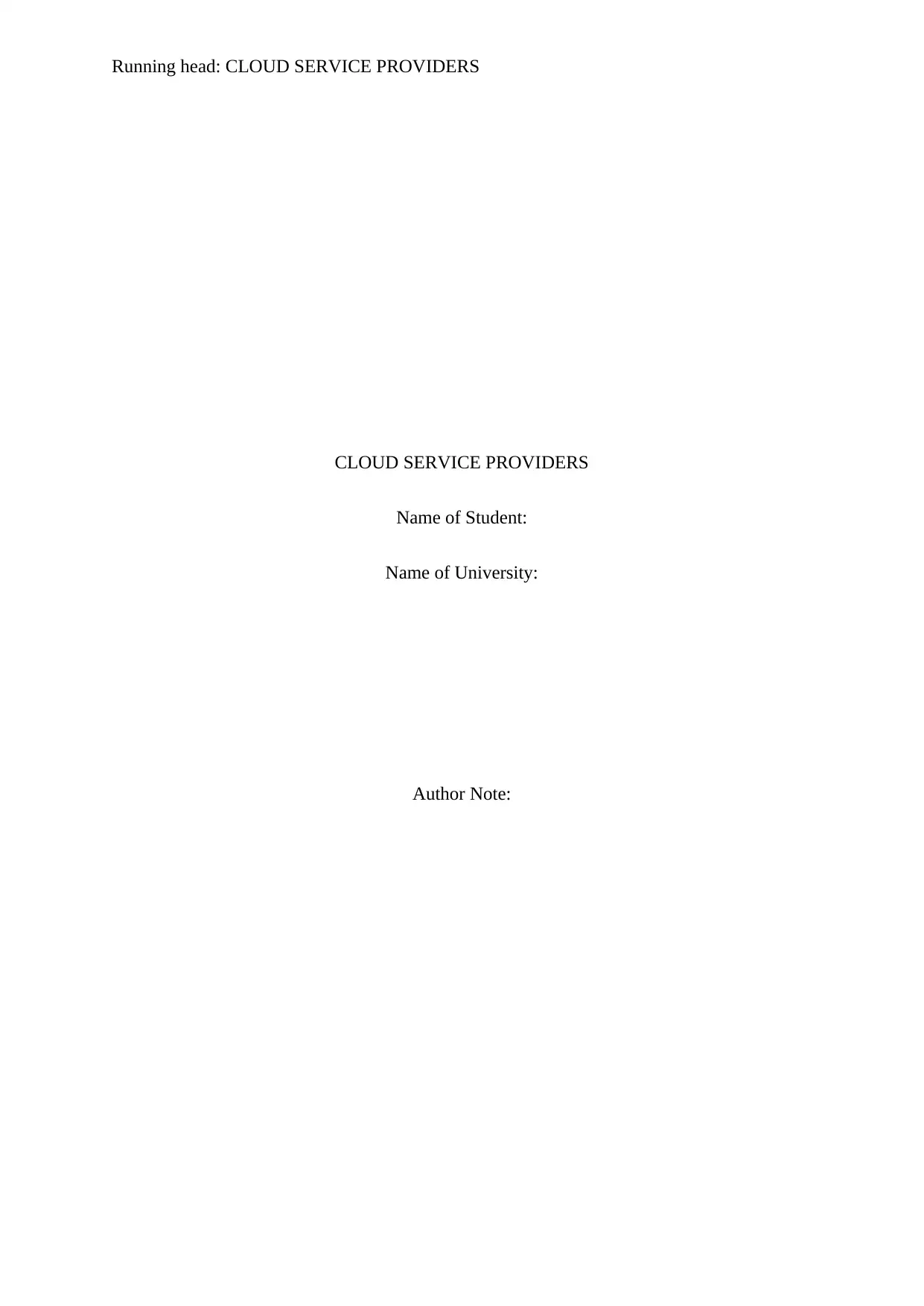
Running head: CLOUD SERVICE PROVIDERS
CLOUD SERVICE PROVIDERS
Name of Student:
Name of University:
Author Note:
CLOUD SERVICE PROVIDERS
Name of Student:
Name of University:
Author Note:
Secure Best Marks with AI Grader
Need help grading? Try our AI Grader for instant feedback on your assignments.

1CLOUD SERVICE PROVIDERS
Table of Contents
Introduction:...............................................................................................................................2
Discussion:.................................................................................................................................2
Cloud service providers:........................................................................................................2
Comparison:...........................................................................................................................5
Conclusion:..............................................................................................................................22
Table of Contents
Introduction:...............................................................................................................................2
Discussion:.................................................................................................................................2
Cloud service providers:........................................................................................................2
Comparison:...........................................................................................................................5
Conclusion:..............................................................................................................................22
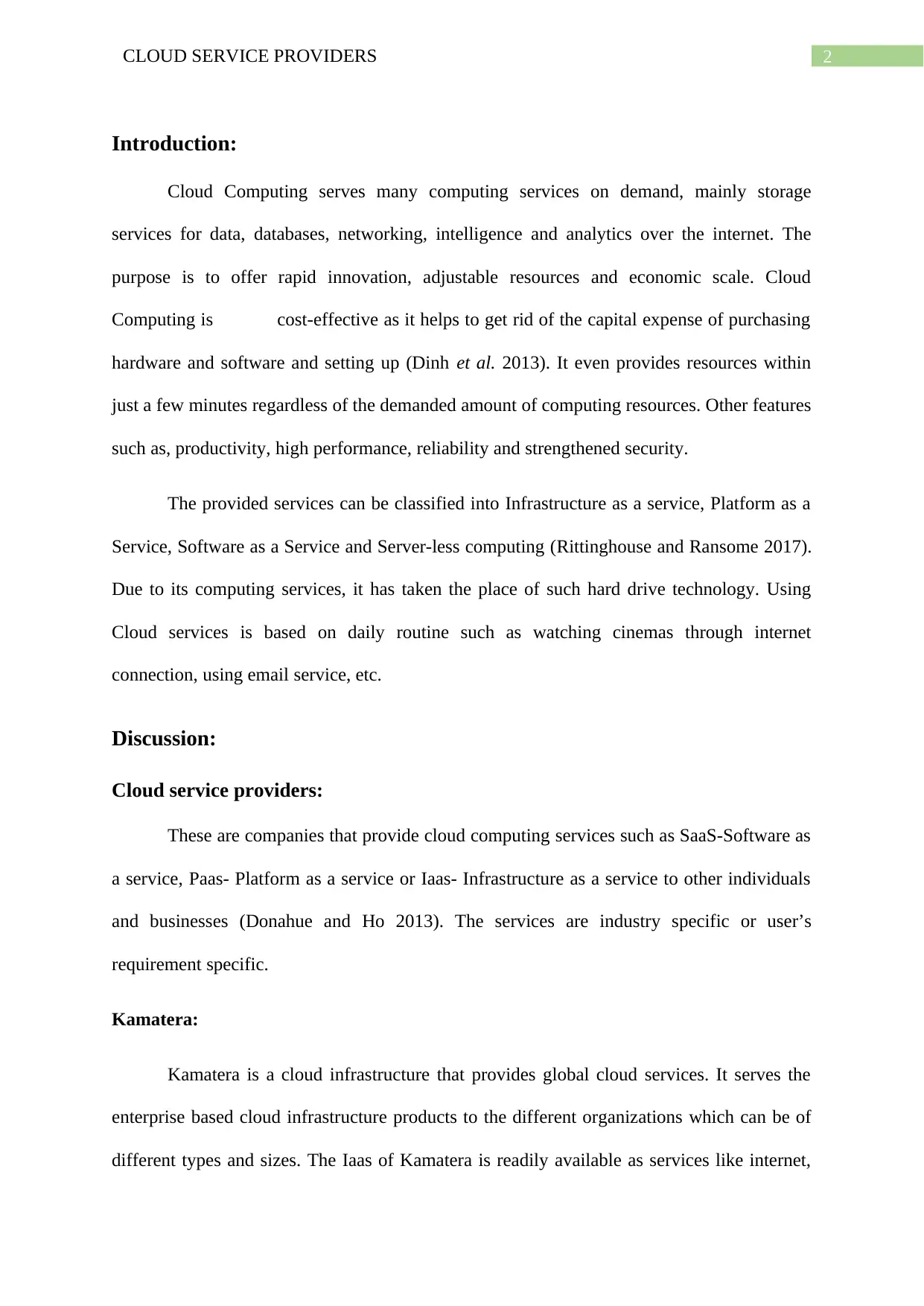
2CLOUD SERVICE PROVIDERS
Introduction:
Cloud Computing serves many computing services on demand, mainly storage
services for data, databases, networking, intelligence and analytics over the internet. The
purpose is to offer rapid innovation, adjustable resources and economic scale. Cloud
Computing is cost-effective as it helps to get rid of the capital expense of purchasing
hardware and software and setting up (Dinh et al. 2013). It even provides resources within
just a few minutes regardless of the demanded amount of computing resources. Other features
such as, productivity, high performance, reliability and strengthened security.
The provided services can be classified into Infrastructure as a service, Platform as a
Service, Software as a Service and Server-less computing (Rittinghouse and Ransome 2017).
Due to its computing services, it has taken the place of such hard drive technology. Using
Cloud services is based on daily routine such as watching cinemas through internet
connection, using email service, etc.
Discussion:
Cloud service providers:
These are companies that provide cloud computing services such as SaaS-Software as
a service, Paas- Platform as a service or Iaas- Infrastructure as a service to other individuals
and businesses (Donahue and Ho 2013). The services are industry specific or user’s
requirement specific.
Kamatera:
Kamatera is a cloud infrastructure that provides global cloud services. It serves the
enterprise based cloud infrastructure products to the different organizations which can be of
different types and sizes. The Iaas of Kamatera is readily available as services like internet,
Introduction:
Cloud Computing serves many computing services on demand, mainly storage
services for data, databases, networking, intelligence and analytics over the internet. The
purpose is to offer rapid innovation, adjustable resources and economic scale. Cloud
Computing is cost-effective as it helps to get rid of the capital expense of purchasing
hardware and software and setting up (Dinh et al. 2013). It even provides resources within
just a few minutes regardless of the demanded amount of computing resources. Other features
such as, productivity, high performance, reliability and strengthened security.
The provided services can be classified into Infrastructure as a service, Platform as a
Service, Software as a Service and Server-less computing (Rittinghouse and Ransome 2017).
Due to its computing services, it has taken the place of such hard drive technology. Using
Cloud services is based on daily routine such as watching cinemas through internet
connection, using email service, etc.
Discussion:
Cloud service providers:
These are companies that provide cloud computing services such as SaaS-Software as
a service, Paas- Platform as a service or Iaas- Infrastructure as a service to other individuals
and businesses (Donahue and Ho 2013). The services are industry specific or user’s
requirement specific.
Kamatera:
Kamatera is a cloud infrastructure that provides global cloud services. It serves the
enterprise based cloud infrastructure products to the different organizations which can be of
different types and sizes. The Iaas of Kamatera is readily available as services like internet,
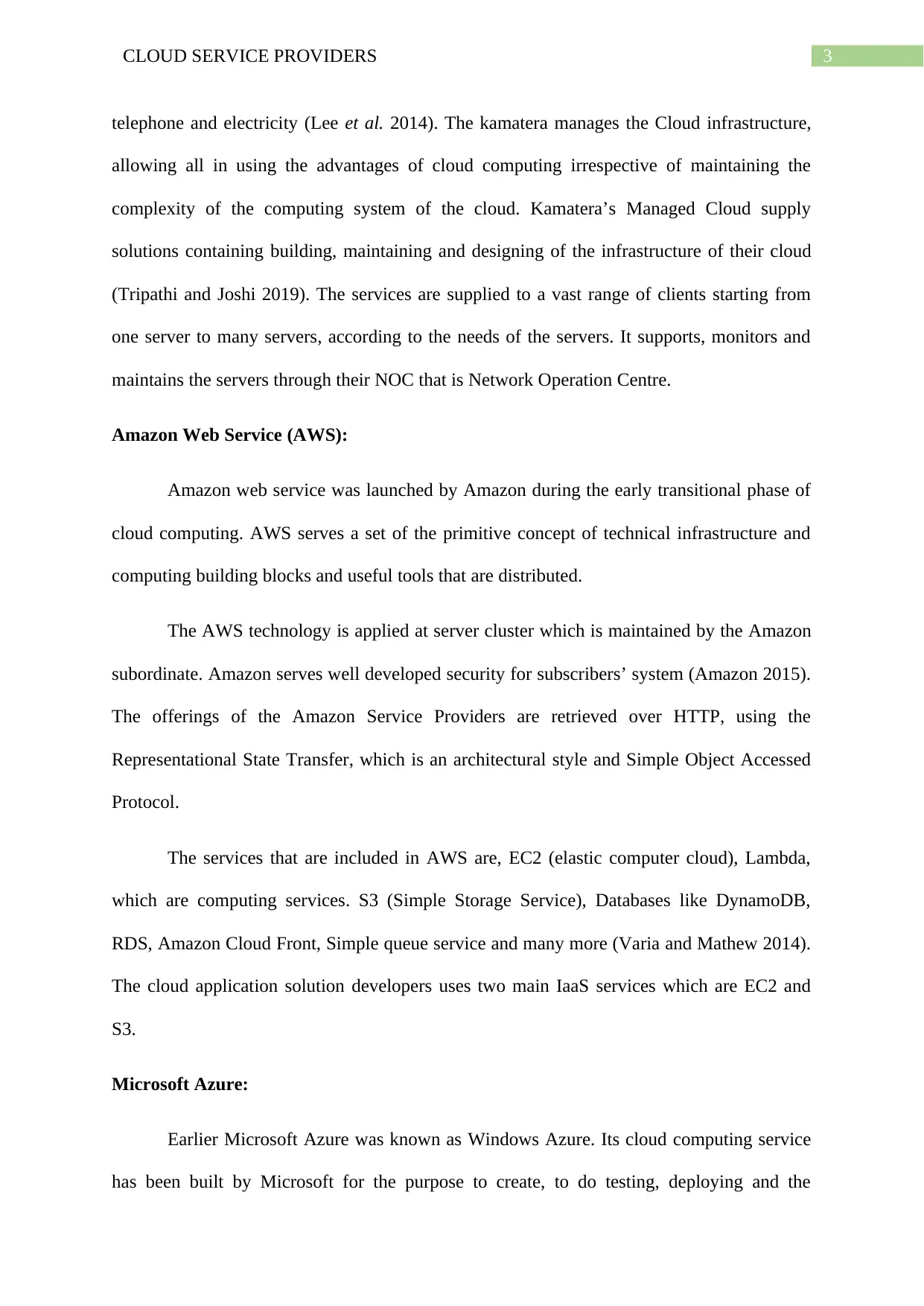
3CLOUD SERVICE PROVIDERS
telephone and electricity (Lee et al. 2014). The kamatera manages the Cloud infrastructure,
allowing all in using the advantages of cloud computing irrespective of maintaining the
complexity of the computing system of the cloud. Kamatera’s Managed Cloud supply
solutions containing building, maintaining and designing of the infrastructure of their cloud
(Tripathi and Joshi 2019). The services are supplied to a vast range of clients starting from
one server to many servers, according to the needs of the servers. It supports, monitors and
maintains the servers through their NOC that is Network Operation Centre.
Amazon Web Service (AWS):
Amazon web service was launched by Amazon during the early transitional phase of
cloud computing. AWS serves a set of the primitive concept of technical infrastructure and
computing building blocks and useful tools that are distributed.
The AWS technology is applied at server cluster which is maintained by the Amazon
subordinate. Amazon serves well developed security for subscribers’ system (Amazon 2015).
The offerings of the Amazon Service Providers are retrieved over HTTP, using the
Representational State Transfer, which is an architectural style and Simple Object Accessed
Protocol.
The services that are included in AWS are, EC2 (elastic computer cloud), Lambda,
which are computing services. S3 (Simple Storage Service), Databases like DynamoDB,
RDS, Amazon Cloud Front, Simple queue service and many more (Varia and Mathew 2014).
The cloud application solution developers uses two main IaaS services which are EC2 and
S3.
Microsoft Azure:
Earlier Microsoft Azure was known as Windows Azure. Its cloud computing service
has been built by Microsoft for the purpose to create, to do testing, deploying and the
telephone and electricity (Lee et al. 2014). The kamatera manages the Cloud infrastructure,
allowing all in using the advantages of cloud computing irrespective of maintaining the
complexity of the computing system of the cloud. Kamatera’s Managed Cloud supply
solutions containing building, maintaining and designing of the infrastructure of their cloud
(Tripathi and Joshi 2019). The services are supplied to a vast range of clients starting from
one server to many servers, according to the needs of the servers. It supports, monitors and
maintains the servers through their NOC that is Network Operation Centre.
Amazon Web Service (AWS):
Amazon web service was launched by Amazon during the early transitional phase of
cloud computing. AWS serves a set of the primitive concept of technical infrastructure and
computing building blocks and useful tools that are distributed.
The AWS technology is applied at server cluster which is maintained by the Amazon
subordinate. Amazon serves well developed security for subscribers’ system (Amazon 2015).
The offerings of the Amazon Service Providers are retrieved over HTTP, using the
Representational State Transfer, which is an architectural style and Simple Object Accessed
Protocol.
The services that are included in AWS are, EC2 (elastic computer cloud), Lambda,
which are computing services. S3 (Simple Storage Service), Databases like DynamoDB,
RDS, Amazon Cloud Front, Simple queue service and many more (Varia and Mathew 2014).
The cloud application solution developers uses two main IaaS services which are EC2 and
S3.
Microsoft Azure:
Earlier Microsoft Azure was known as Windows Azure. Its cloud computing service
has been built by Microsoft for the purpose to create, to do testing, deploying and the
Secure Best Marks with AI Grader
Need help grading? Try our AI Grader for instant feedback on your assignments.
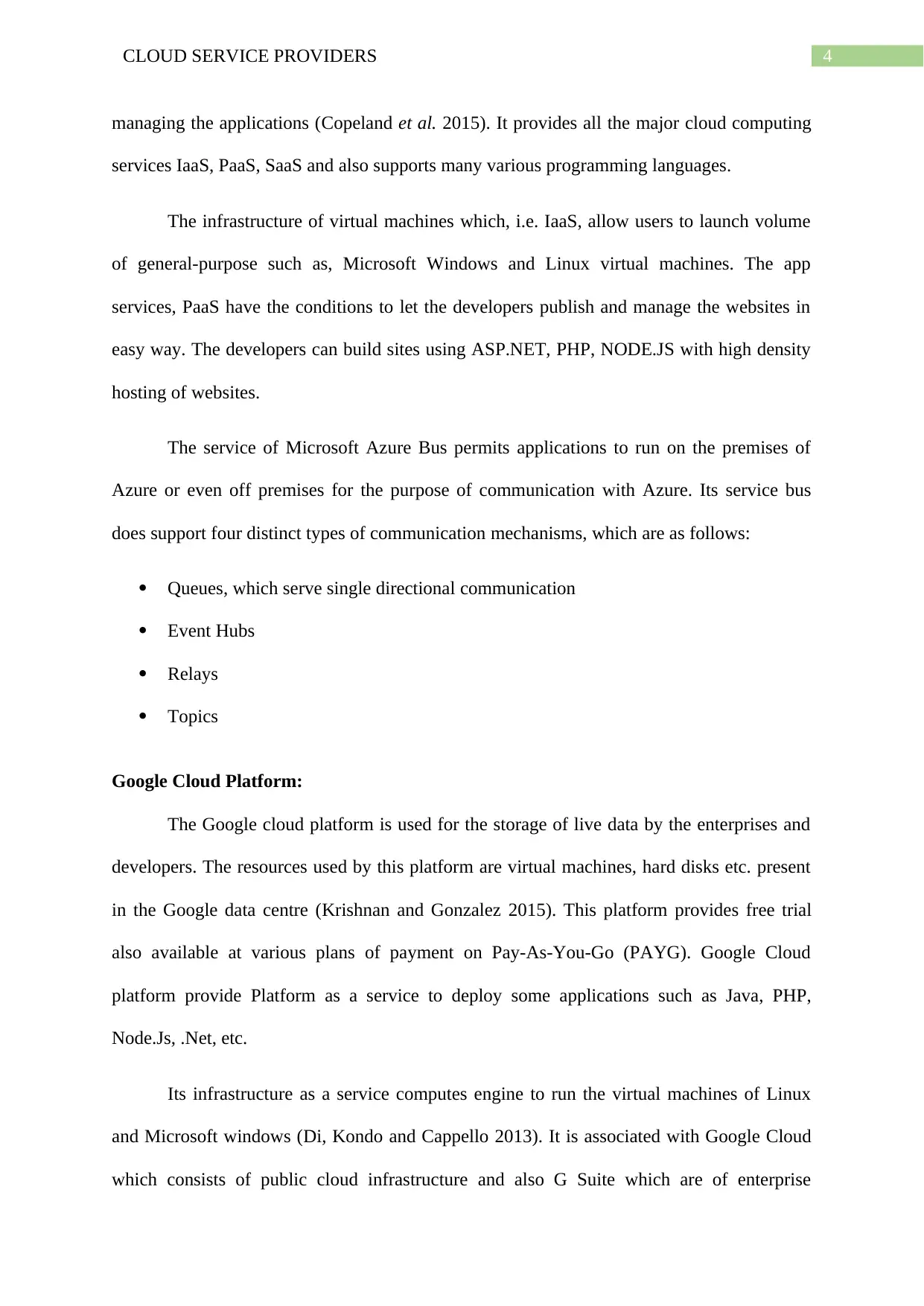
4CLOUD SERVICE PROVIDERS
managing the applications (Copeland et al. 2015). It provides all the major cloud computing
services IaaS, PaaS, SaaS and also supports many various programming languages.
The infrastructure of virtual machines which, i.e. IaaS, allow users to launch volume
of general-purpose such as, Microsoft Windows and Linux virtual machines. The app
services, PaaS have the conditions to let the developers publish and manage the websites in
easy way. The developers can build sites using ASP.NET, PHP, NODE.JS with high density
hosting of websites.
The service of Microsoft Azure Bus permits applications to run on the premises of
Azure or even off premises for the purpose of communication with Azure. Its service bus
does support four distinct types of communication mechanisms, which are as follows:
Queues, which serve single directional communication
Event Hubs
Relays
Topics
Google Cloud Platform:
The Google cloud platform is used for the storage of live data by the enterprises and
developers. The resources used by this platform are virtual machines, hard disks etc. present
in the Google data centre (Krishnan and Gonzalez 2015). This platform provides free trial
also available at various plans of payment on Pay-As-You-Go (PAYG). Google Cloud
platform provide Platform as a service to deploy some applications such as Java, PHP,
Node.Js, .Net, etc.
Its infrastructure as a service computes engine to run the virtual machines of Linux
and Microsoft windows (Di, Kondo and Cappello 2013). It is associated with Google Cloud
which consists of public cloud infrastructure and also G Suite which are of enterprise
managing the applications (Copeland et al. 2015). It provides all the major cloud computing
services IaaS, PaaS, SaaS and also supports many various programming languages.
The infrastructure of virtual machines which, i.e. IaaS, allow users to launch volume
of general-purpose such as, Microsoft Windows and Linux virtual machines. The app
services, PaaS have the conditions to let the developers publish and manage the websites in
easy way. The developers can build sites using ASP.NET, PHP, NODE.JS with high density
hosting of websites.
The service of Microsoft Azure Bus permits applications to run on the premises of
Azure or even off premises for the purpose of communication with Azure. Its service bus
does support four distinct types of communication mechanisms, which are as follows:
Queues, which serve single directional communication
Event Hubs
Relays
Topics
Google Cloud Platform:
The Google cloud platform is used for the storage of live data by the enterprises and
developers. The resources used by this platform are virtual machines, hard disks etc. present
in the Google data centre (Krishnan and Gonzalez 2015). This platform provides free trial
also available at various plans of payment on Pay-As-You-Go (PAYG). Google Cloud
platform provide Platform as a service to deploy some applications such as Java, PHP,
Node.Js, .Net, etc.
Its infrastructure as a service computes engine to run the virtual machines of Linux
and Microsoft windows (Di, Kondo and Cappello 2013). It is associated with Google Cloud
which consists of public cloud infrastructure and also G Suite which are of enterprise
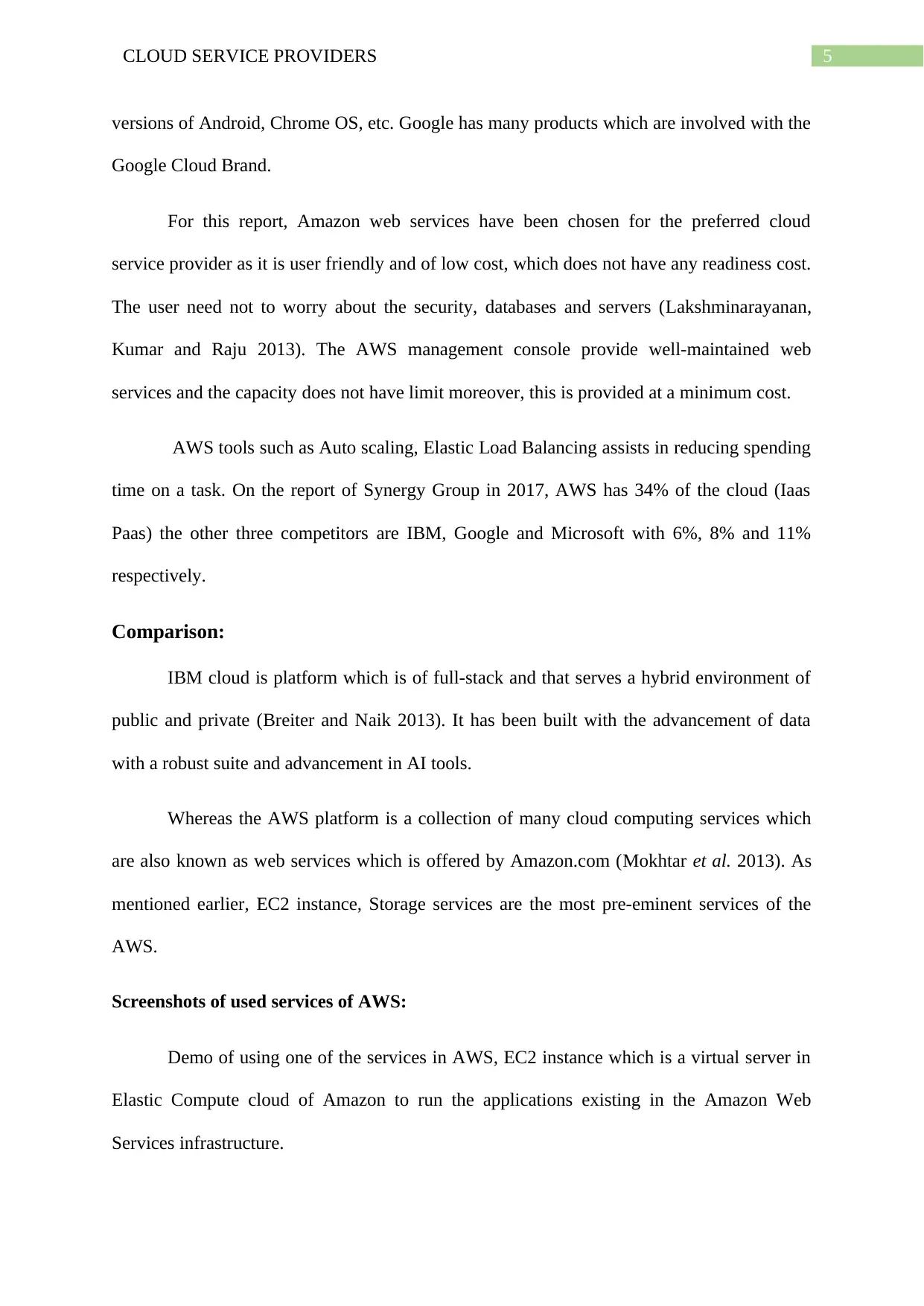
5CLOUD SERVICE PROVIDERS
versions of Android, Chrome OS, etc. Google has many products which are involved with the
Google Cloud Brand.
For this report, Amazon web services have been chosen for the preferred cloud
service provider as it is user friendly and of low cost, which does not have any readiness cost.
The user need not to worry about the security, databases and servers (Lakshminarayanan,
Kumar and Raju 2013). The AWS management console provide well-maintained web
services and the capacity does not have limit moreover, this is provided at a minimum cost.
AWS tools such as Auto scaling, Elastic Load Balancing assists in reducing spending
time on a task. On the report of Synergy Group in 2017, AWS has 34% of the cloud (Iaas
Paas) the other three competitors are IBM, Google and Microsoft with 6%, 8% and 11%
respectively.
Comparison:
IBM cloud is platform which is of full-stack and that serves a hybrid environment of
public and private (Breiter and Naik 2013). It has been built with the advancement of data
with a robust suite and advancement in AI tools.
Whereas the AWS platform is a collection of many cloud computing services which
are also known as web services which is offered by Amazon.com (Mokhtar et al. 2013). As
mentioned earlier, EC2 instance, Storage services are the most pre-eminent services of the
AWS.
Screenshots of used services of AWS:
Demo of using one of the services in AWS, EC2 instance which is a virtual server in
Elastic Compute cloud of Amazon to run the applications existing in the Amazon Web
Services infrastructure.
versions of Android, Chrome OS, etc. Google has many products which are involved with the
Google Cloud Brand.
For this report, Amazon web services have been chosen for the preferred cloud
service provider as it is user friendly and of low cost, which does not have any readiness cost.
The user need not to worry about the security, databases and servers (Lakshminarayanan,
Kumar and Raju 2013). The AWS management console provide well-maintained web
services and the capacity does not have limit moreover, this is provided at a minimum cost.
AWS tools such as Auto scaling, Elastic Load Balancing assists in reducing spending
time on a task. On the report of Synergy Group in 2017, AWS has 34% of the cloud (Iaas
Paas) the other three competitors are IBM, Google and Microsoft with 6%, 8% and 11%
respectively.
Comparison:
IBM cloud is platform which is of full-stack and that serves a hybrid environment of
public and private (Breiter and Naik 2013). It has been built with the advancement of data
with a robust suite and advancement in AI tools.
Whereas the AWS platform is a collection of many cloud computing services which
are also known as web services which is offered by Amazon.com (Mokhtar et al. 2013). As
mentioned earlier, EC2 instance, Storage services are the most pre-eminent services of the
AWS.
Screenshots of used services of AWS:
Demo of using one of the services in AWS, EC2 instance which is a virtual server in
Elastic Compute cloud of Amazon to run the applications existing in the Amazon Web
Services infrastructure.
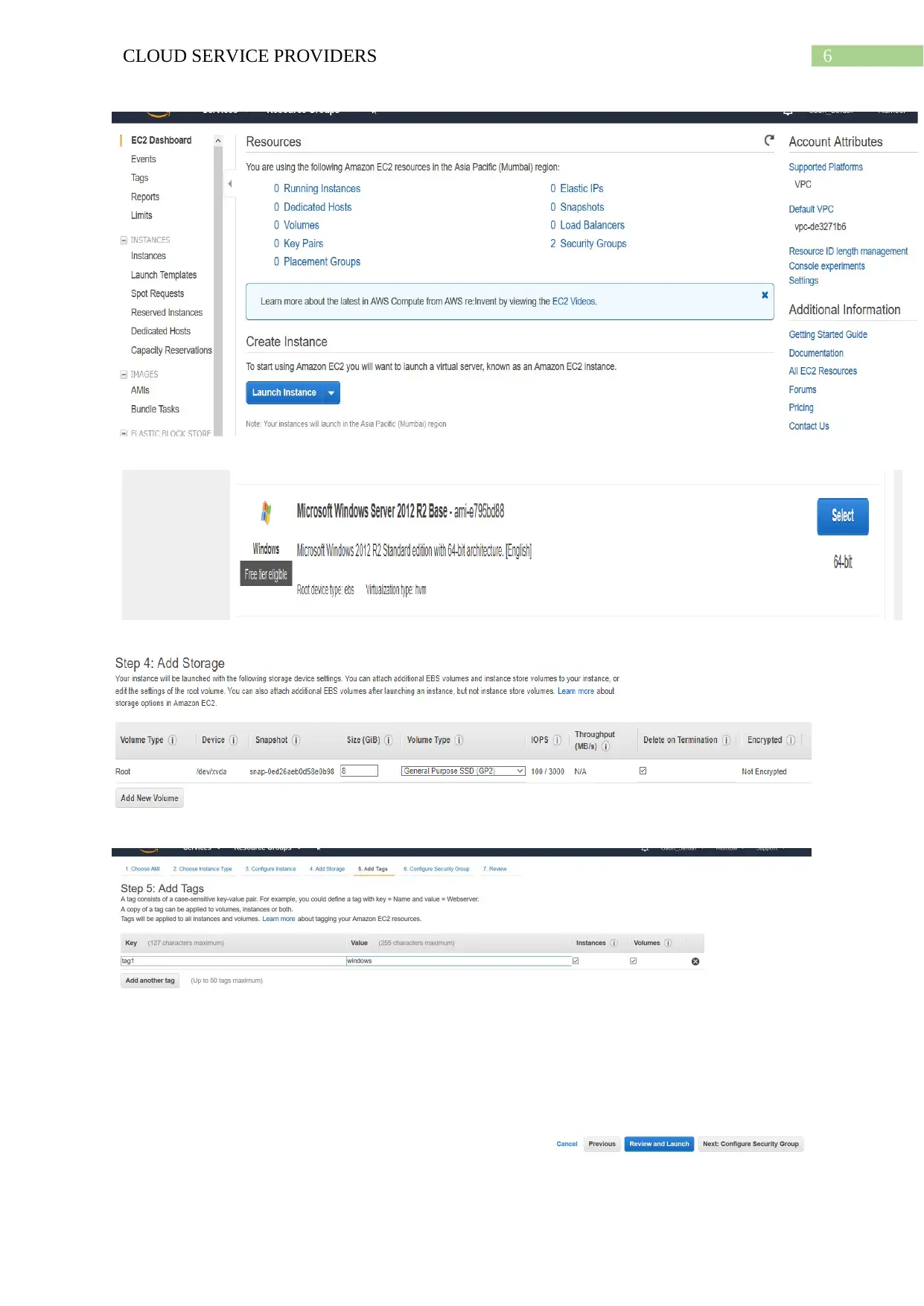
6CLOUD SERVICE PROVIDERS
Paraphrase This Document
Need a fresh take? Get an instant paraphrase of this document with our AI Paraphraser
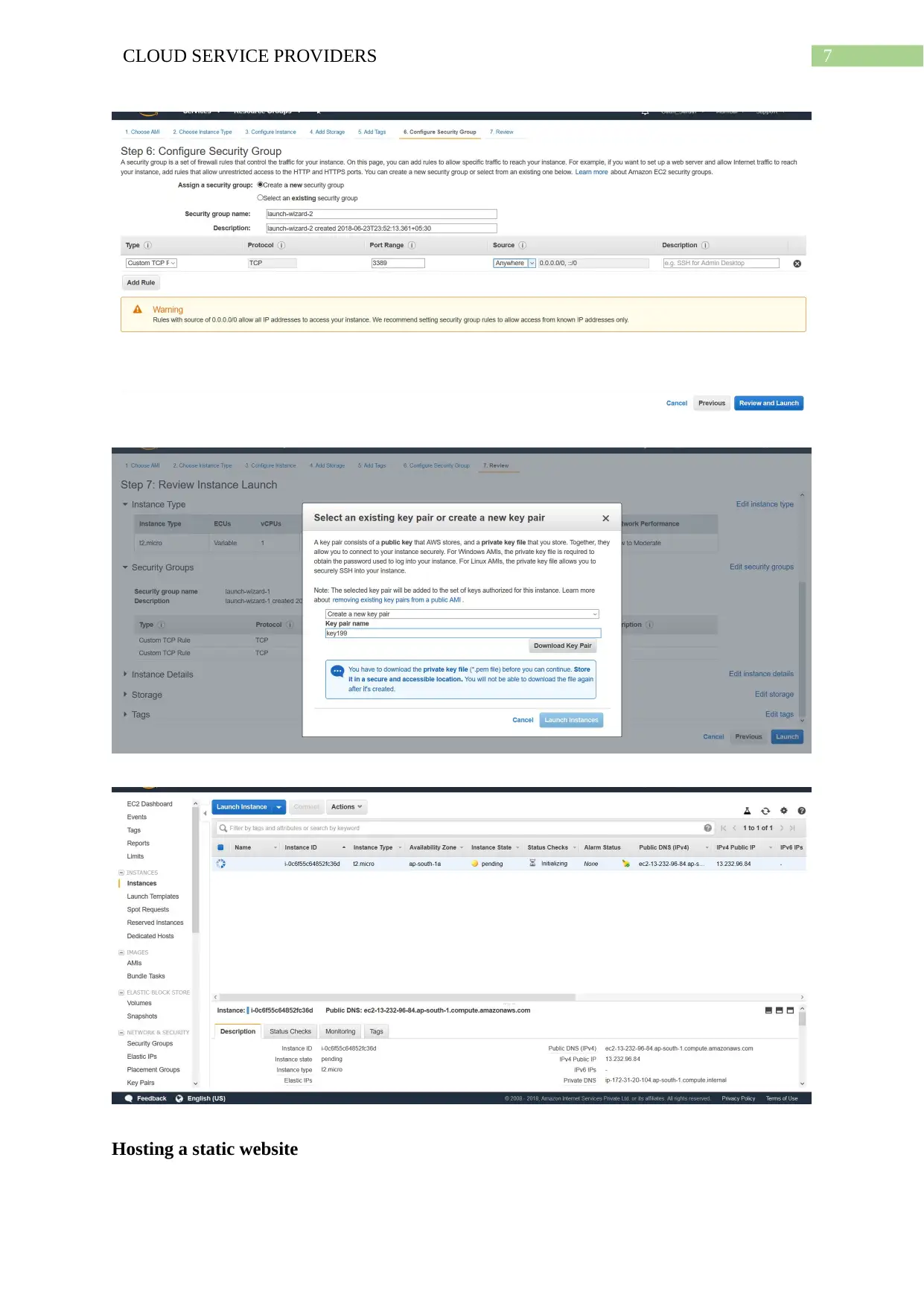
7CLOUD SERVICE PROVIDERS
Hosting a static website
Hosting a static website
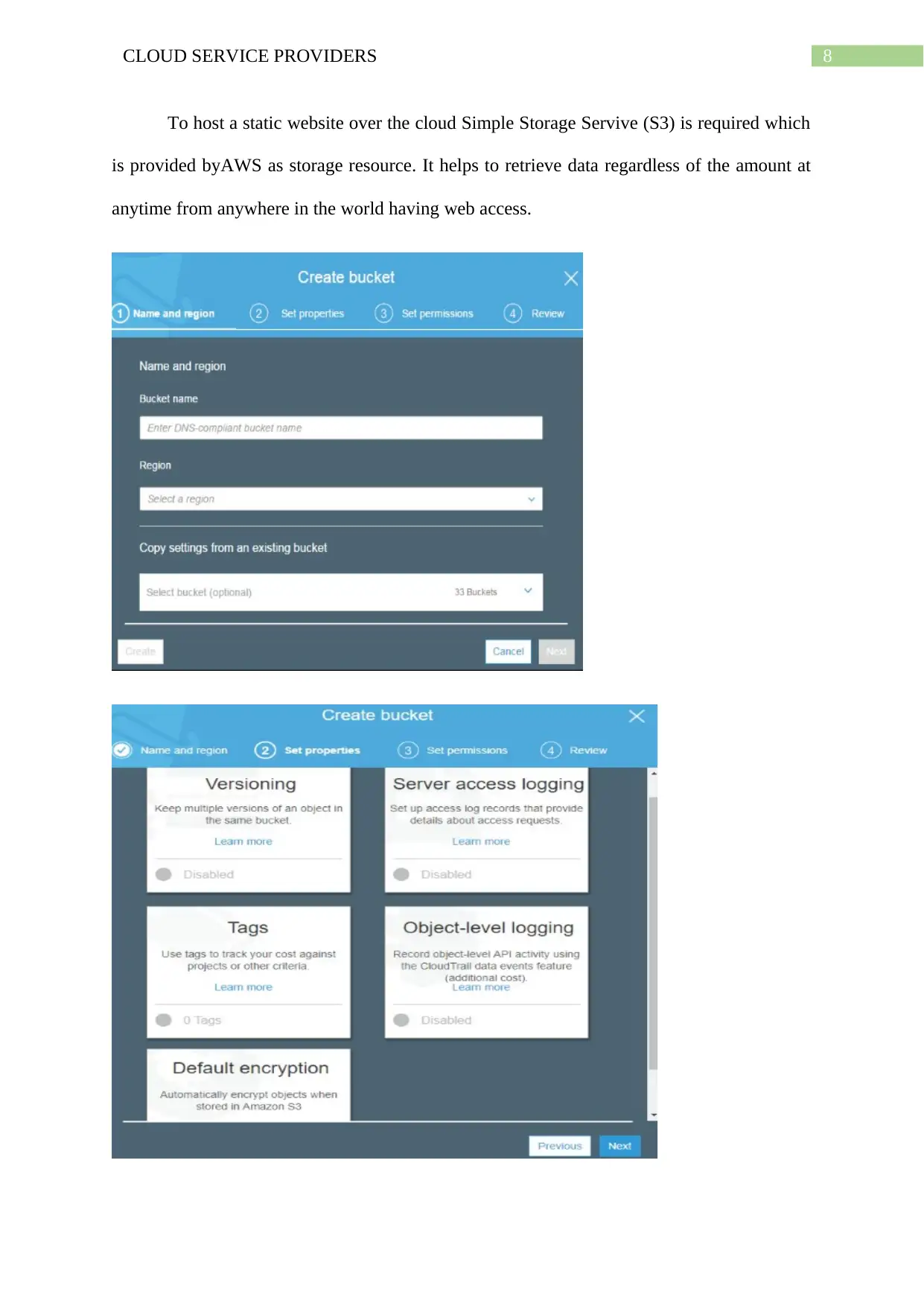
8CLOUD SERVICE PROVIDERS
To host a static website over the cloud Simple Storage Servive (S3) is required which
is provided byAWS as storage resource. It helps to retrieve data regardless of the amount at
anytime from anywhere in the world having web access.
To host a static website over the cloud Simple Storage Servive (S3) is required which
is provided byAWS as storage resource. It helps to retrieve data regardless of the amount at
anytime from anywhere in the world having web access.
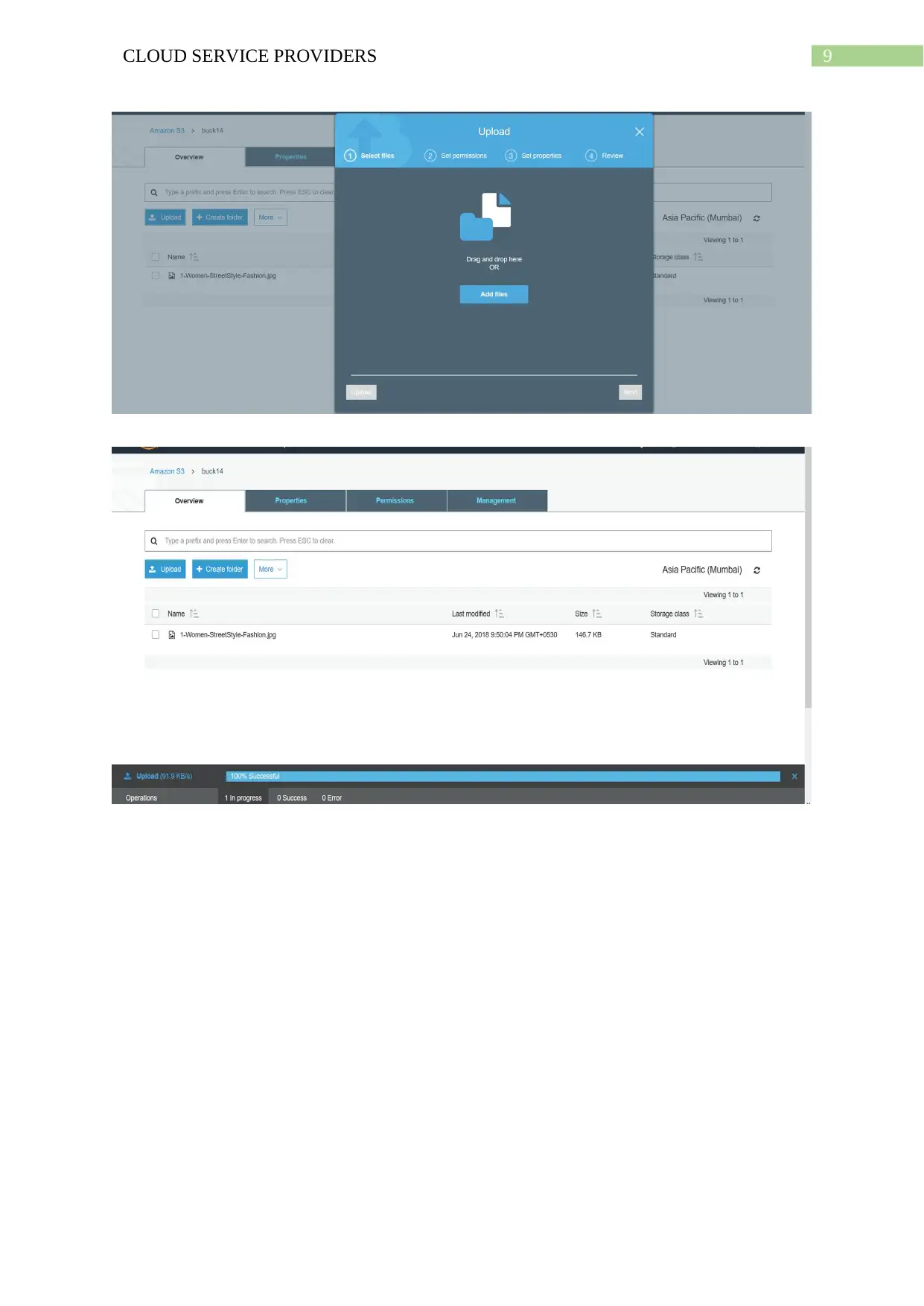
9CLOUD SERVICE PROVIDERS
Secure Best Marks with AI Grader
Need help grading? Try our AI Grader for instant feedback on your assignments.
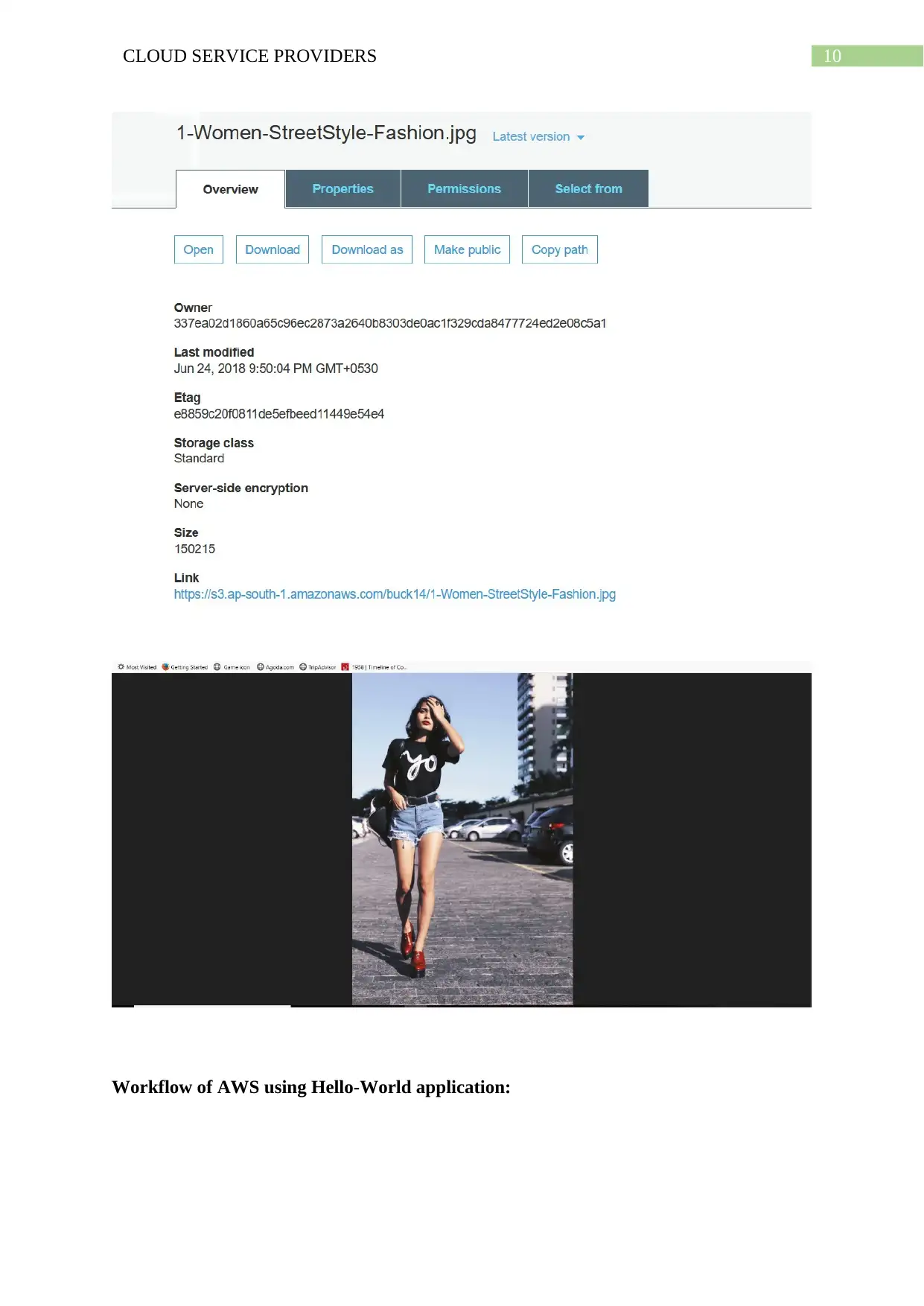
10CLOUD SERVICE PROVIDERS
Workflow of AWS using Hello-World application:
Workflow of AWS using Hello-World application:
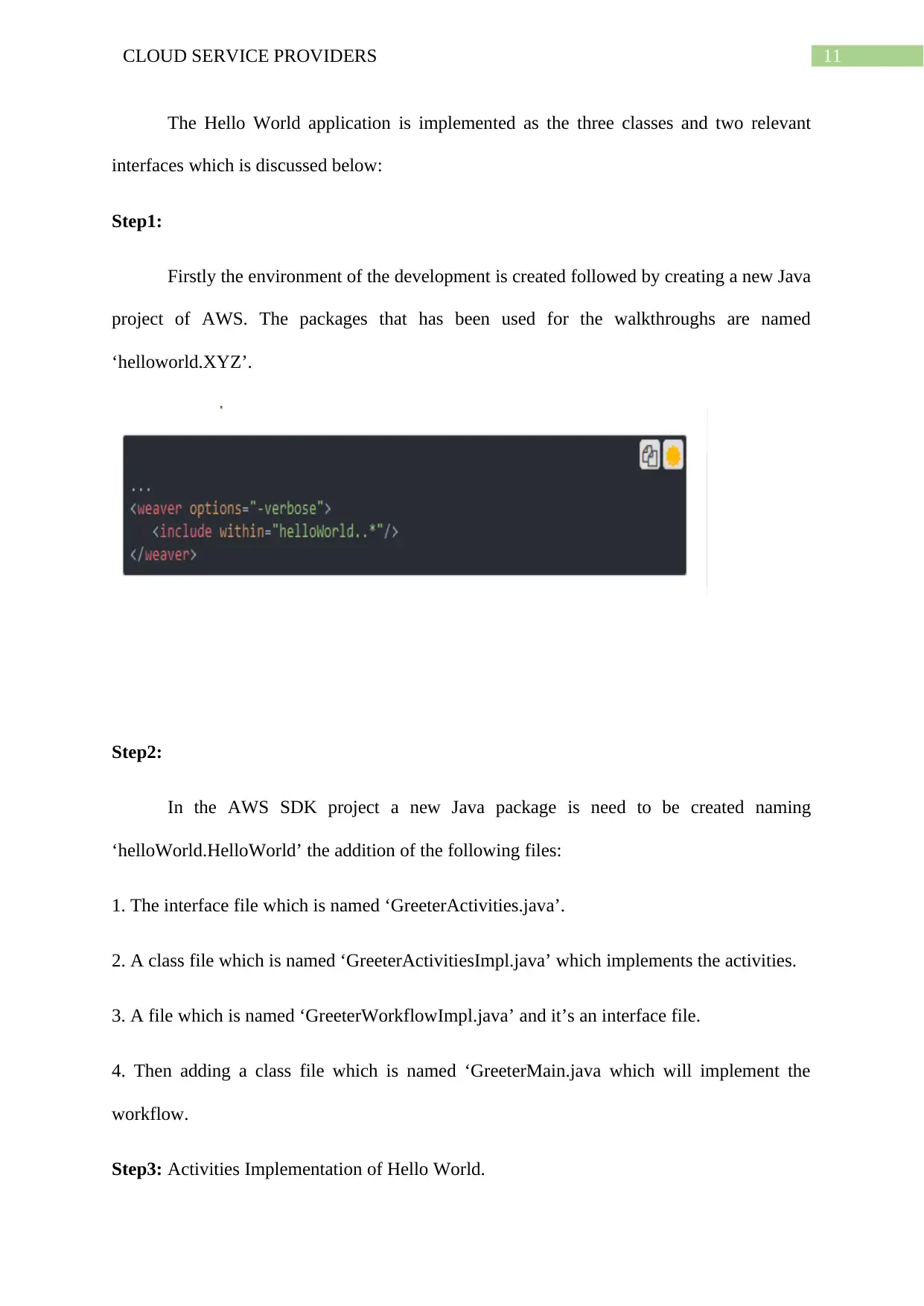
11CLOUD SERVICE PROVIDERS
The Hello World application is implemented as the three classes and two relevant
interfaces which is discussed below:
Step1:
Firstly the environment of the development is created followed by creating a new Java
project of AWS. The packages that has been used for the walkthroughs are named
‘helloworld.XYZ’.
Step2:
In the AWS SDK project a new Java package is need to be created naming
‘helloWorld.HelloWorld’ the addition of the following files:
1. The interface file which is named ‘GreeterActivities.java’.
2. A class file which is named ‘GreeterActivitiesImpl.java’ which implements the activities.
3. A file which is named ‘GreeterWorkflowImpl.java’ and it’s an interface file.
4. Then adding a class file which is named ‘GreeterMain.java which will implement the
workflow.
Step3: Activities Implementation of Hello World.
The Hello World application is implemented as the three classes and two relevant
interfaces which is discussed below:
Step1:
Firstly the environment of the development is created followed by creating a new Java
project of AWS. The packages that has been used for the walkthroughs are named
‘helloworld.XYZ’.
Step2:
In the AWS SDK project a new Java package is need to be created naming
‘helloWorld.HelloWorld’ the addition of the following files:
1. The interface file which is named ‘GreeterActivities.java’.
2. A class file which is named ‘GreeterActivitiesImpl.java’ which implements the activities.
3. A file which is named ‘GreeterWorkflowImpl.java’ and it’s an interface file.
4. Then adding a class file which is named ‘GreeterMain.java which will implement the
workflow.
Step3: Activities Implementation of Hello World.
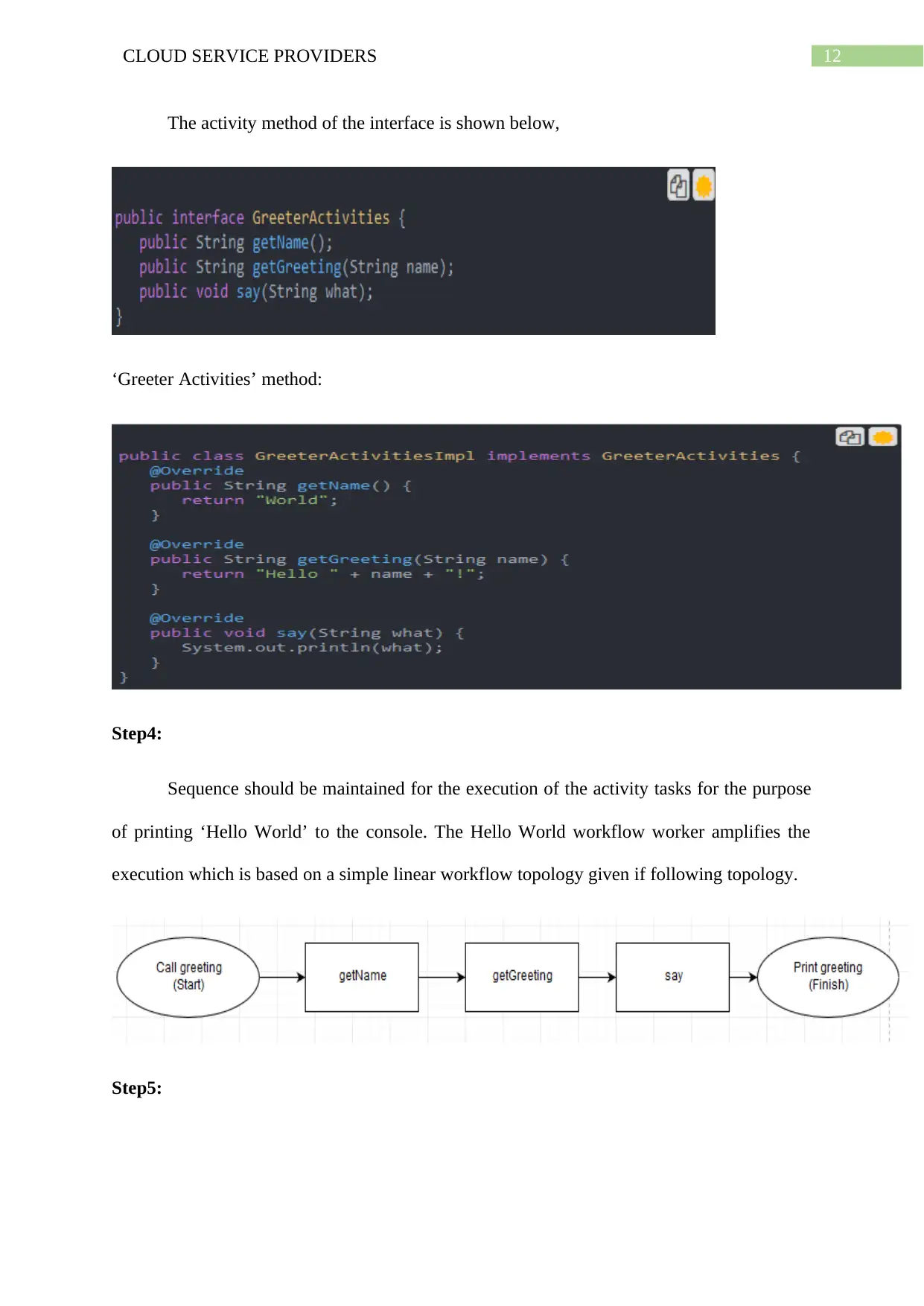
12CLOUD SERVICE PROVIDERS
The activity method of the interface is shown below,
‘Greeter Activities’ method:
Step4:
Sequence should be maintained for the execution of the activity tasks for the purpose
of printing ‘Hello World’ to the console. The Hello World workflow worker amplifies the
execution which is based on a simple linear workflow topology given if following topology.
Step5:
The activity method of the interface is shown below,
‘Greeter Activities’ method:
Step4:
Sequence should be maintained for the execution of the activity tasks for the purpose
of printing ‘Hello World’ to the console. The Hello World workflow worker amplifies the
execution which is based on a simple linear workflow topology given if following topology.
Step5:
Paraphrase This Document
Need a fresh take? Get an instant paraphrase of this document with our AI Paraphraser
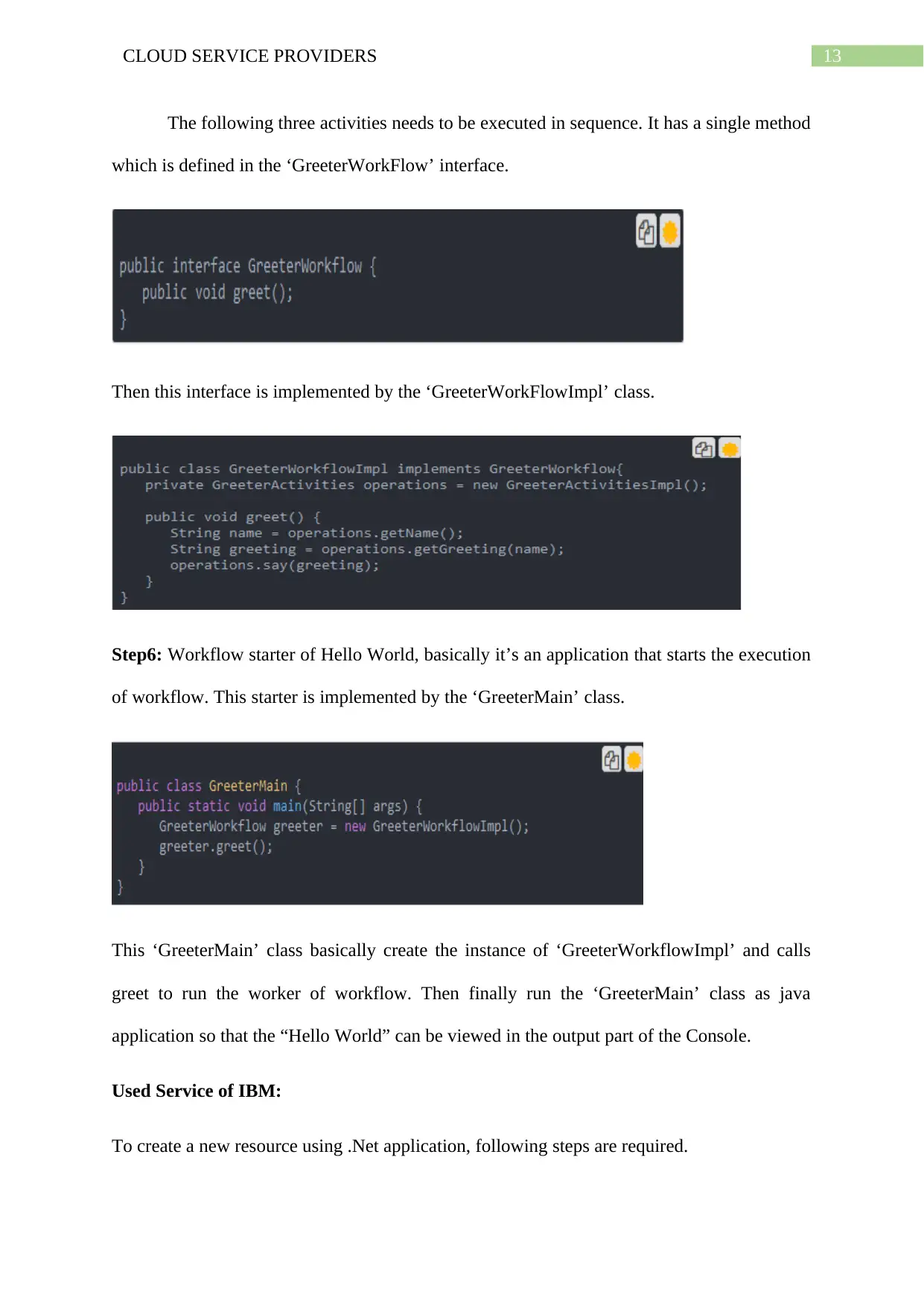
13CLOUD SERVICE PROVIDERS
The following three activities needs to be executed in sequence. It has a single method
which is defined in the ‘GreeterWorkFlow’ interface.
Then this interface is implemented by the ‘GreeterWorkFlowImpl’ class.
Step6: Workflow starter of Hello World, basically it’s an application that starts the execution
of workflow. This starter is implemented by the ‘GreeterMain’ class.
This ‘GreeterMain’ class basically create the instance of ‘GreeterWorkflowImpl’ and calls
greet to run the worker of workflow. Then finally run the ‘GreeterMain’ class as java
application so that the “Hello World” can be viewed in the output part of the Console.
Used Service of IBM:
To create a new resource using .Net application, following steps are required.
The following three activities needs to be executed in sequence. It has a single method
which is defined in the ‘GreeterWorkFlow’ interface.
Then this interface is implemented by the ‘GreeterWorkFlowImpl’ class.
Step6: Workflow starter of Hello World, basically it’s an application that starts the execution
of workflow. This starter is implemented by the ‘GreeterMain’ class.
This ‘GreeterMain’ class basically create the instance of ‘GreeterWorkflowImpl’ and calls
greet to run the worker of workflow. Then finally run the ‘GreeterMain’ class as java
application so that the “Hello World” can be viewed in the output part of the Console.
Used Service of IBM:
To create a new resource using .Net application, following steps are required.
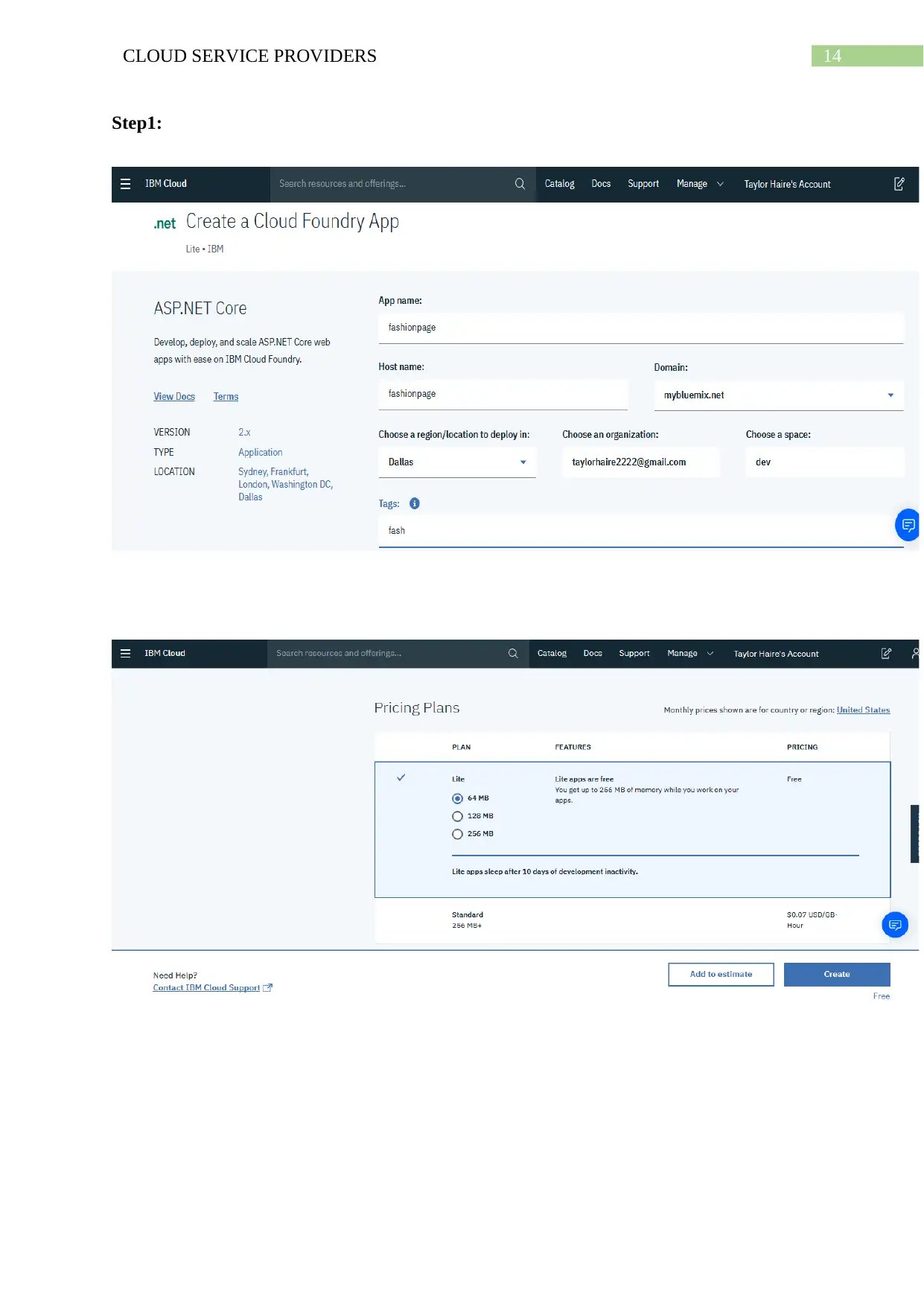
14CLOUD SERVICE PROVIDERS
Step1:
Step1:
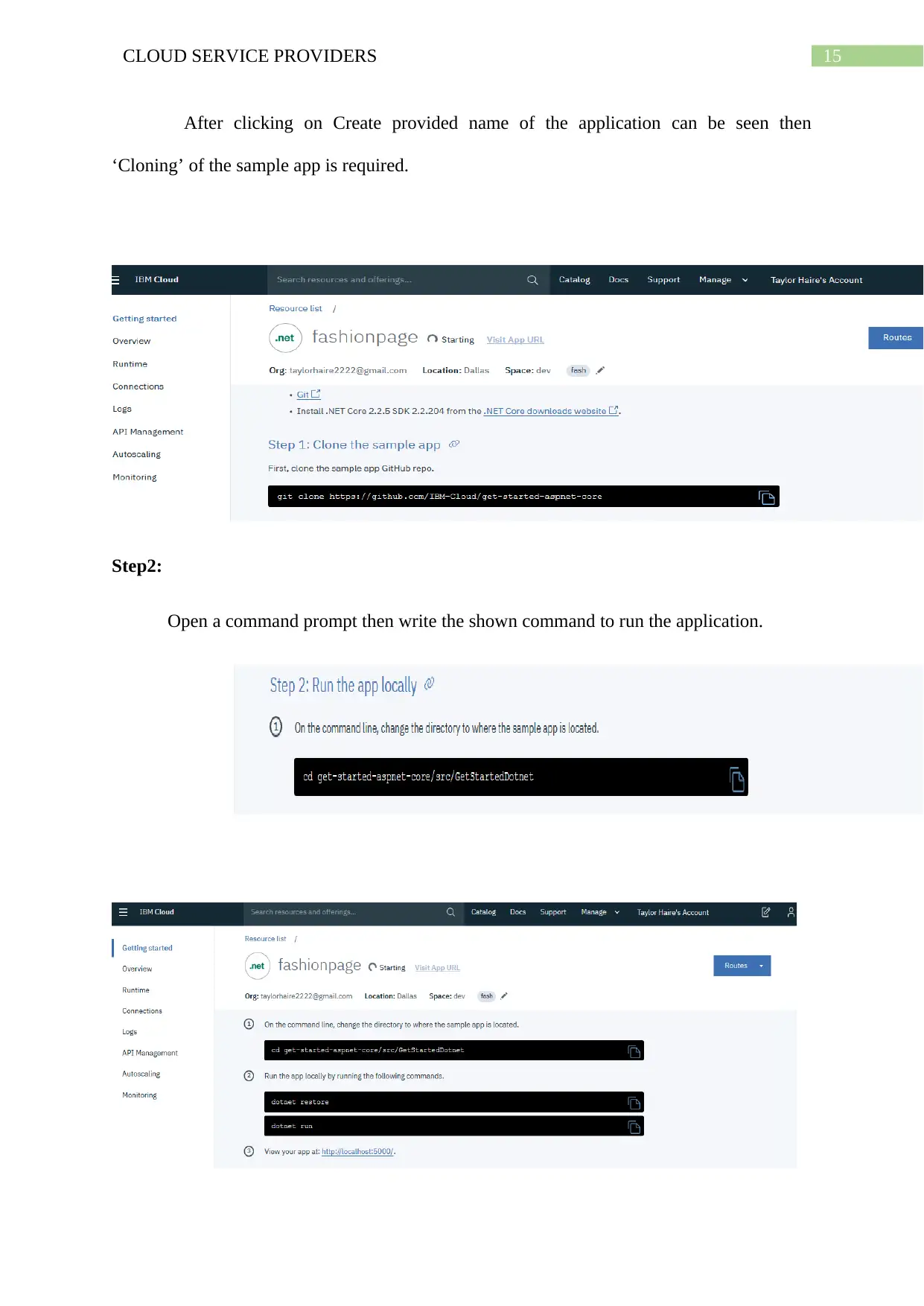
15CLOUD SERVICE PROVIDERS
After clicking on Create provided name of the application can be seen then
‘Cloning’ of the sample app is required.
Step2:
Open a command prompt then write the shown command to run the application.
After clicking on Create provided name of the application can be seen then
‘Cloning’ of the sample app is required.
Step2:
Open a command prompt then write the shown command to run the application.
Secure Best Marks with AI Grader
Need help grading? Try our AI Grader for instant feedback on your assignments.
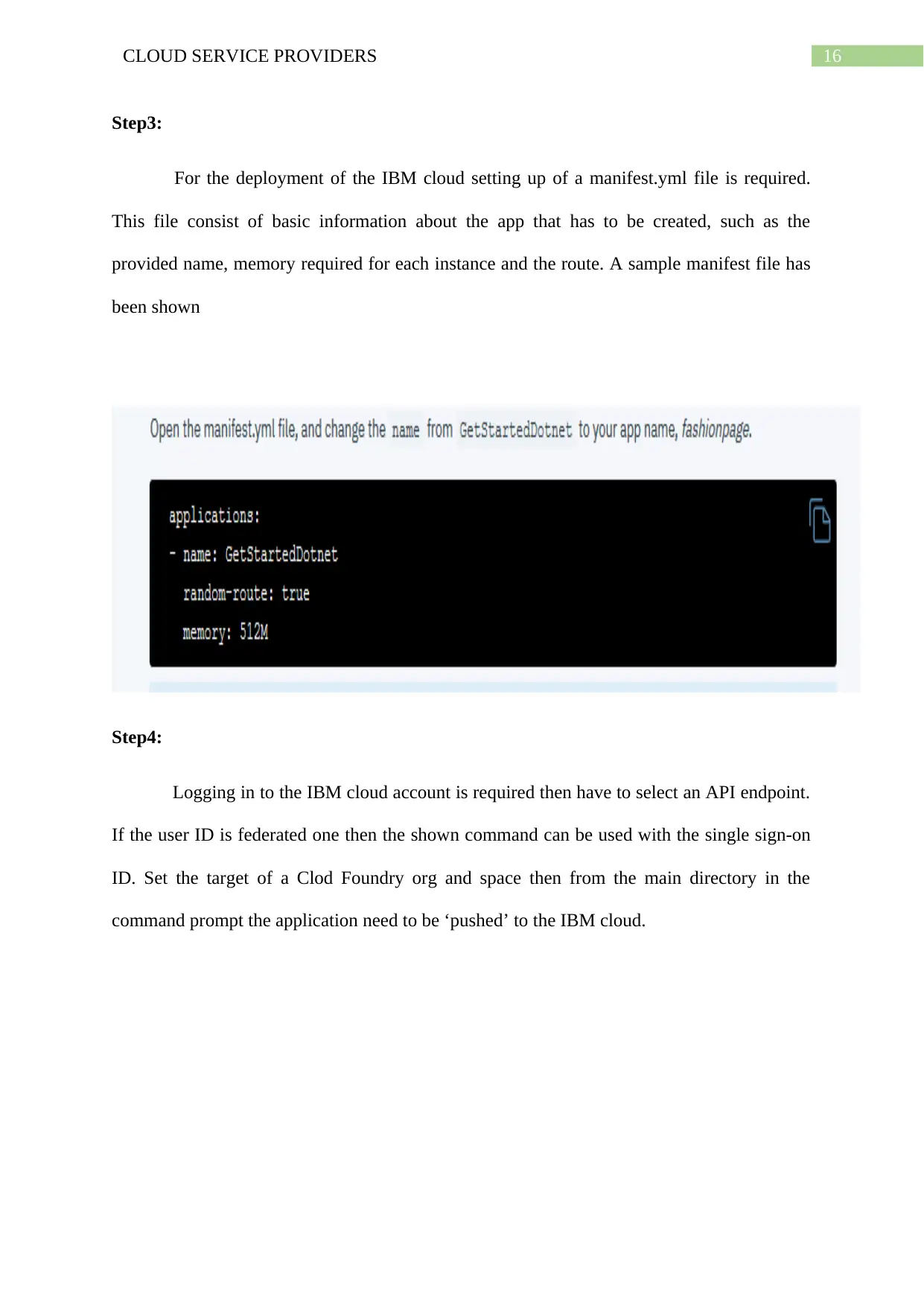
16CLOUD SERVICE PROVIDERS
Step3:
For the deployment of the IBM cloud setting up of a manifest.yml file is required.
This file consist of basic information about the app that has to be created, such as the
provided name, memory required for each instance and the route. A sample manifest file has
been shown
Step4:
Logging in to the IBM cloud account is required then have to select an API endpoint.
If the user ID is federated one then the shown command can be used with the single sign-on
ID. Set the target of a Clod Foundry org and space then from the main directory in the
command prompt the application need to be ‘pushed’ to the IBM cloud.
Step3:
For the deployment of the IBM cloud setting up of a manifest.yml file is required.
This file consist of basic information about the app that has to be created, such as the
provided name, memory required for each instance and the route. A sample manifest file has
been shown
Step4:
Logging in to the IBM cloud account is required then have to select an API endpoint.
If the user ID is federated one then the shown command can be used with the single sign-on
ID. Set the target of a Clod Foundry org and space then from the main directory in the
command prompt the application need to be ‘pushed’ to the IBM cloud.
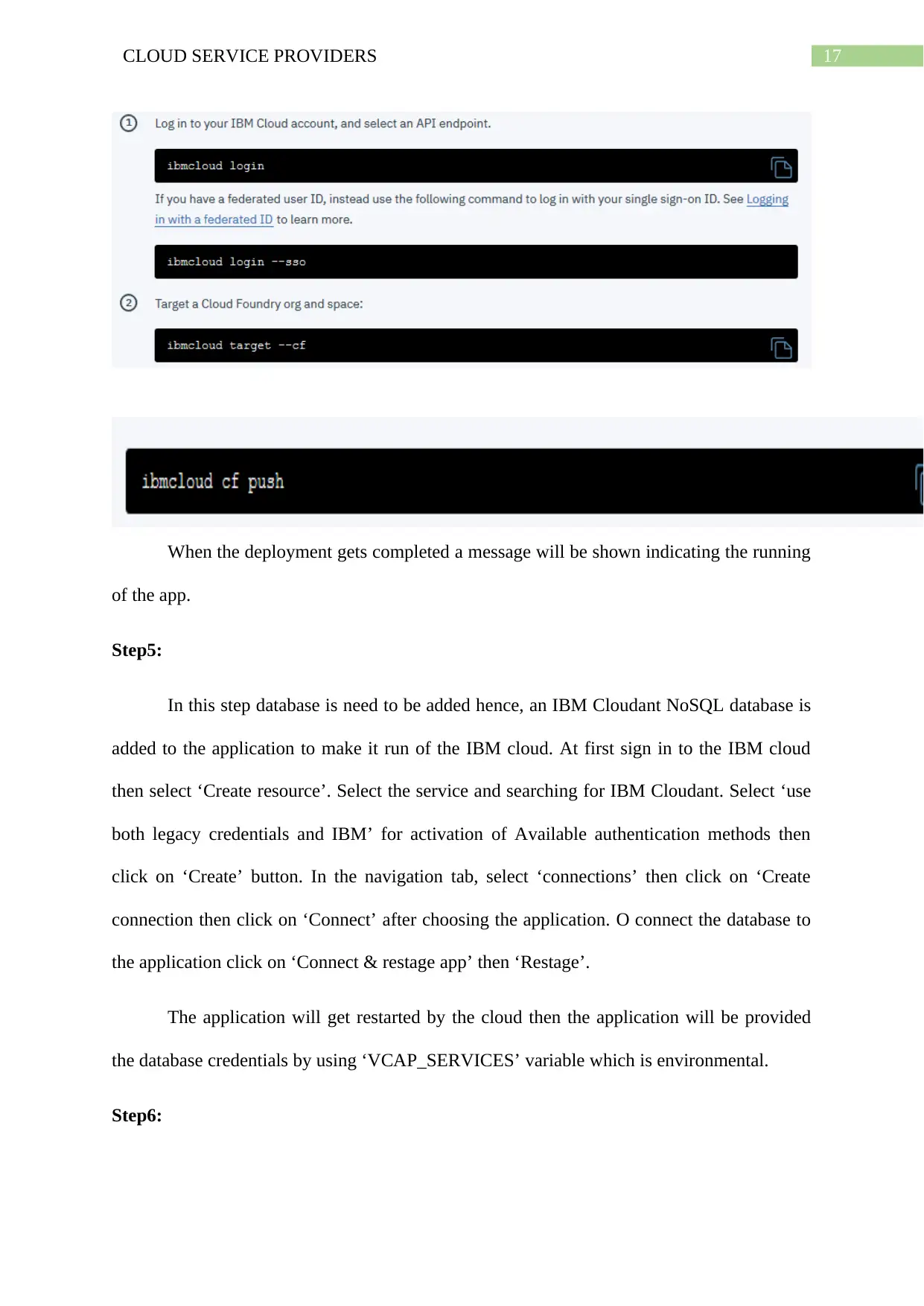
17CLOUD SERVICE PROVIDERS
When the deployment gets completed a message will be shown indicating the running
of the app.
Step5:
In this step database is need to be added hence, an IBM Cloudant NoSQL database is
added to the application to make it run of the IBM cloud. At first sign in to the IBM cloud
then select ‘Create resource’. Select the service and searching for IBM Cloudant. Select ‘use
both legacy credentials and IBM’ for activation of Available authentication methods then
click on ‘Create’ button. In the navigation tab, select ‘connections’ then click on ‘Create
connection then click on ‘Connect’ after choosing the application. O connect the database to
the application click on ‘Connect & restage app’ then ‘Restage’.
The application will get restarted by the cloud then the application will be provided
the database credentials by using ‘VCAP_SERVICES’ variable which is environmental.
Step6:
When the deployment gets completed a message will be shown indicating the running
of the app.
Step5:
In this step database is need to be added hence, an IBM Cloudant NoSQL database is
added to the application to make it run of the IBM cloud. At first sign in to the IBM cloud
then select ‘Create resource’. Select the service and searching for IBM Cloudant. Select ‘use
both legacy credentials and IBM’ for activation of Available authentication methods then
click on ‘Create’ button. In the navigation tab, select ‘connections’ then click on ‘Create
connection then click on ‘Connect’ after choosing the application. O connect the database to
the application click on ‘Connect & restage app’ then ‘Restage’.
The application will get restarted by the cloud then the application will be provided
the database credentials by using ‘VCAP_SERVICES’ variable which is environmental.
Step6:
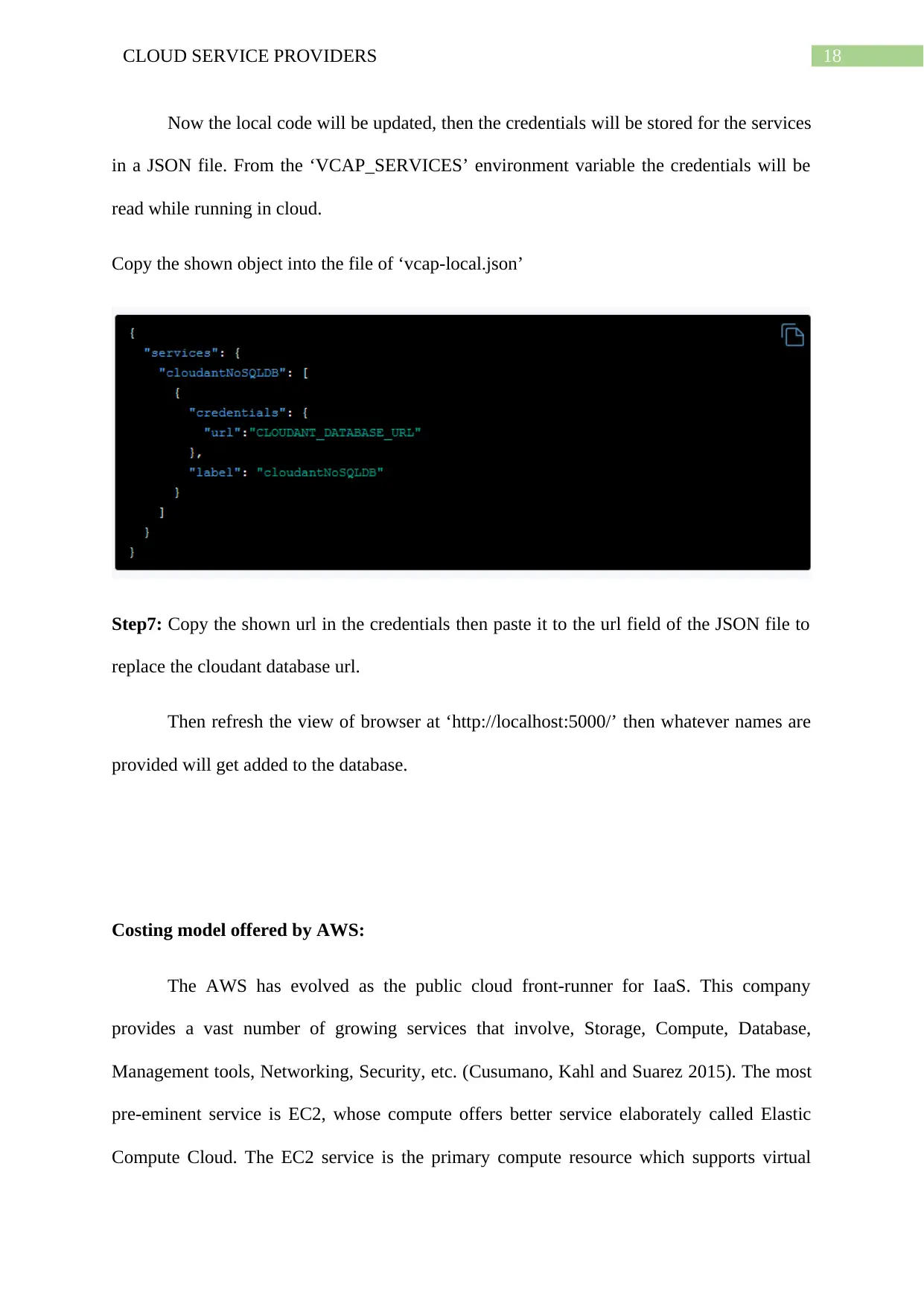
18CLOUD SERVICE PROVIDERS
Now the local code will be updated, then the credentials will be stored for the services
in a JSON file. From the ‘VCAP_SERVICES’ environment variable the credentials will be
read while running in cloud.
Copy the shown object into the file of ‘vcap-local.json’
Step7: Copy the shown url in the credentials then paste it to the url field of the JSON file to
replace the cloudant database url.
Then refresh the view of browser at ‘http://localhost:5000/’ then whatever names are
provided will get added to the database.
Costing model offered by AWS:
The AWS has evolved as the public cloud front-runner for IaaS. This company
provides a vast number of growing services that involve, Storage, Compute, Database,
Management tools, Networking, Security, etc. (Cusumano, Kahl and Suarez 2015). The most
pre-eminent service is EC2, whose compute offers better service elaborately called Elastic
Compute Cloud. The EC2 service is the primary compute resource which supports virtual
Now the local code will be updated, then the credentials will be stored for the services
in a JSON file. From the ‘VCAP_SERVICES’ environment variable the credentials will be
read while running in cloud.
Copy the shown object into the file of ‘vcap-local.json’
Step7: Copy the shown url in the credentials then paste it to the url field of the JSON file to
replace the cloudant database url.
Then refresh the view of browser at ‘http://localhost:5000/’ then whatever names are
provided will get added to the database.
Costing model offered by AWS:
The AWS has evolved as the public cloud front-runner for IaaS. This company
provides a vast number of growing services that involve, Storage, Compute, Database,
Management tools, Networking, Security, etc. (Cusumano, Kahl and Suarez 2015). The most
pre-eminent service is EC2, whose compute offers better service elaborately called Elastic
Compute Cloud. The EC2 service is the primary compute resource which supports virtual
Paraphrase This Document
Need a fresh take? Get an instant paraphrase of this document with our AI Paraphraser
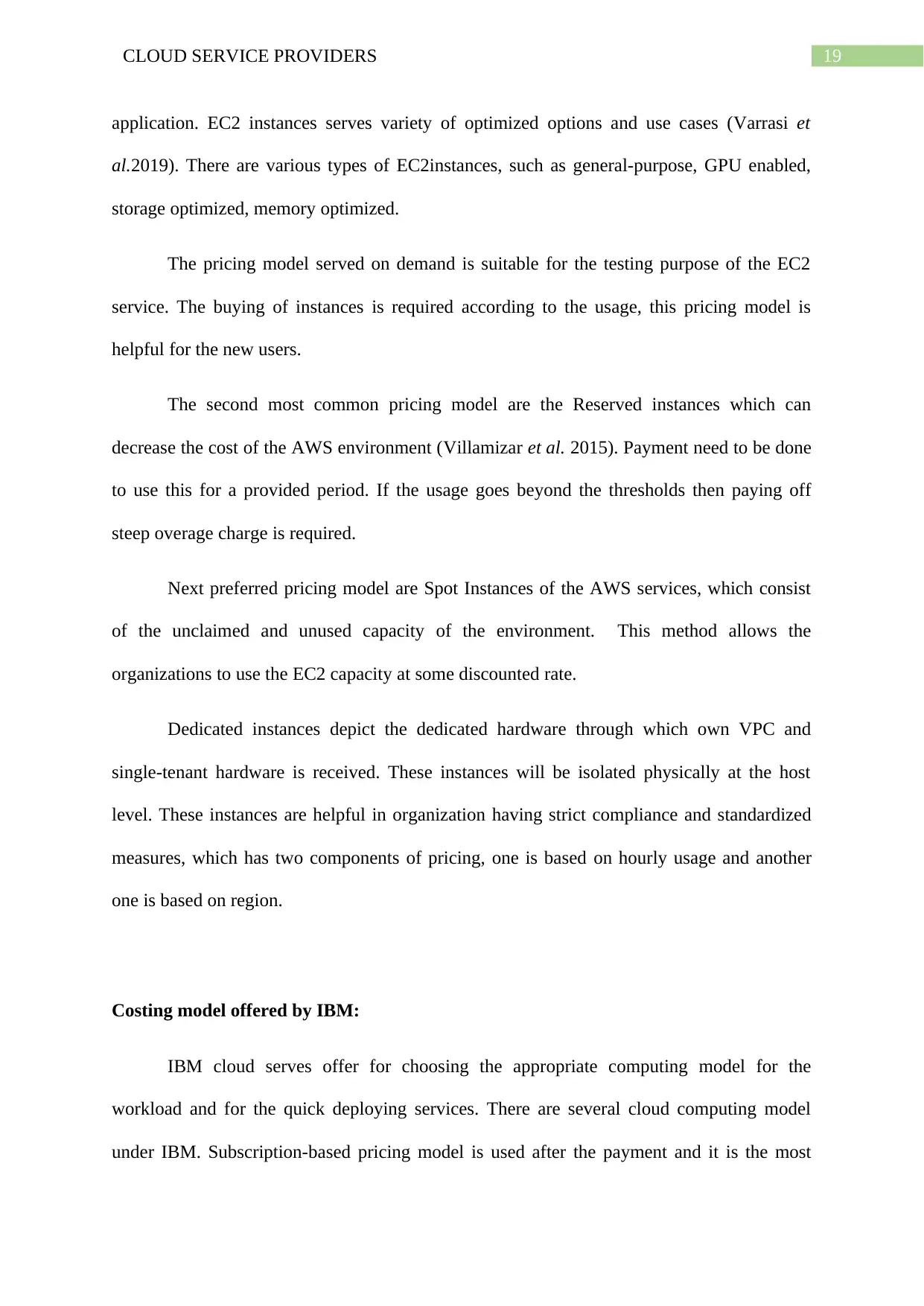
19CLOUD SERVICE PROVIDERS
application. EC2 instances serves variety of optimized options and use cases (Varrasi et
al.2019). There are various types of EC2instances, such as general-purpose, GPU enabled,
storage optimized, memory optimized.
The pricing model served on demand is suitable for the testing purpose of the EC2
service. The buying of instances is required according to the usage, this pricing model is
helpful for the new users.
The second most common pricing model are the Reserved instances which can
decrease the cost of the AWS environment (Villamizar et al. 2015). Payment need to be done
to use this for a provided period. If the usage goes beyond the thresholds then paying off
steep overage charge is required.
Next preferred pricing model are Spot Instances of the AWS services, which consist
of the unclaimed and unused capacity of the environment. This method allows the
organizations to use the EC2 capacity at some discounted rate.
Dedicated instances depict the dedicated hardware through which own VPC and
single-tenant hardware is received. These instances will be isolated physically at the host
level. These instances are helpful in organization having strict compliance and standardized
measures, which has two components of pricing, one is based on hourly usage and another
one is based on region.
Costing model offered by IBM:
IBM cloud serves offer for choosing the appropriate computing model for the
workload and for the quick deploying services. There are several cloud computing model
under IBM. Subscription-based pricing model is used after the payment and it is the most
application. EC2 instances serves variety of optimized options and use cases (Varrasi et
al.2019). There are various types of EC2instances, such as general-purpose, GPU enabled,
storage optimized, memory optimized.
The pricing model served on demand is suitable for the testing purpose of the EC2
service. The buying of instances is required according to the usage, this pricing model is
helpful for the new users.
The second most common pricing model are the Reserved instances which can
decrease the cost of the AWS environment (Villamizar et al. 2015). Payment need to be done
to use this for a provided period. If the usage goes beyond the thresholds then paying off
steep overage charge is required.
Next preferred pricing model are Spot Instances of the AWS services, which consist
of the unclaimed and unused capacity of the environment. This method allows the
organizations to use the EC2 capacity at some discounted rate.
Dedicated instances depict the dedicated hardware through which own VPC and
single-tenant hardware is received. These instances will be isolated physically at the host
level. These instances are helpful in organization having strict compliance and standardized
measures, which has two components of pricing, one is based on hourly usage and another
one is based on region.
Costing model offered by IBM:
IBM cloud serves offer for choosing the appropriate computing model for the
workload and for the quick deploying services. There are several cloud computing model
under IBM. Subscription-based pricing model is used after the payment and it is the most
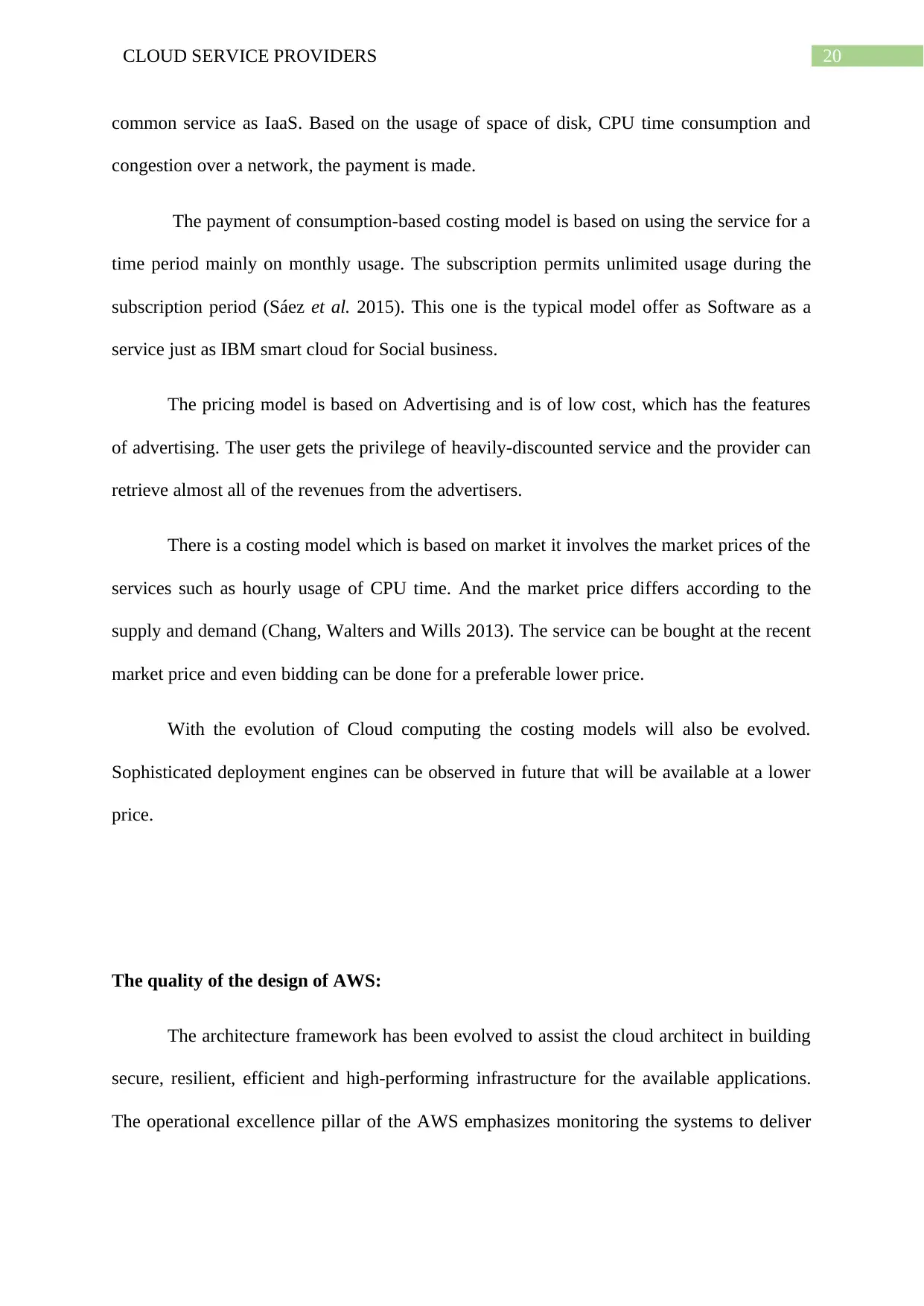
20CLOUD SERVICE PROVIDERS
common service as IaaS. Based on the usage of space of disk, CPU time consumption and
congestion over a network, the payment is made.
The payment of consumption-based costing model is based on using the service for a
time period mainly on monthly usage. The subscription permits unlimited usage during the
subscription period (Sáez et al. 2015). This one is the typical model offer as Software as a
service just as IBM smart cloud for Social business.
The pricing model is based on Advertising and is of low cost, which has the features
of advertising. The user gets the privilege of heavily-discounted service and the provider can
retrieve almost all of the revenues from the advertisers.
There is a costing model which is based on market it involves the market prices of the
services such as hourly usage of CPU time. And the market price differs according to the
supply and demand (Chang, Walters and Wills 2013). The service can be bought at the recent
market price and even bidding can be done for a preferable lower price.
With the evolution of Cloud computing the costing models will also be evolved.
Sophisticated deployment engines can be observed in future that will be available at a lower
price.
The quality of the design of AWS:
The architecture framework has been evolved to assist the cloud architect in building
secure, resilient, efficient and high-performing infrastructure for the available applications.
The operational excellence pillar of the AWS emphasizes monitoring the systems to deliver
common service as IaaS. Based on the usage of space of disk, CPU time consumption and
congestion over a network, the payment is made.
The payment of consumption-based costing model is based on using the service for a
time period mainly on monthly usage. The subscription permits unlimited usage during the
subscription period (Sáez et al. 2015). This one is the typical model offer as Software as a
service just as IBM smart cloud for Social business.
The pricing model is based on Advertising and is of low cost, which has the features
of advertising. The user gets the privilege of heavily-discounted service and the provider can
retrieve almost all of the revenues from the advertisers.
There is a costing model which is based on market it involves the market prices of the
services such as hourly usage of CPU time. And the market price differs according to the
supply and demand (Chang, Walters and Wills 2013). The service can be bought at the recent
market price and even bidding can be done for a preferable lower price.
With the evolution of Cloud computing the costing models will also be evolved.
Sophisticated deployment engines can be observed in future that will be available at a lower
price.
The quality of the design of AWS:
The architecture framework has been evolved to assist the cloud architect in building
secure, resilient, efficient and high-performing infrastructure for the available applications.
The operational excellence pillar of the AWS emphasizes monitoring the systems to deliver
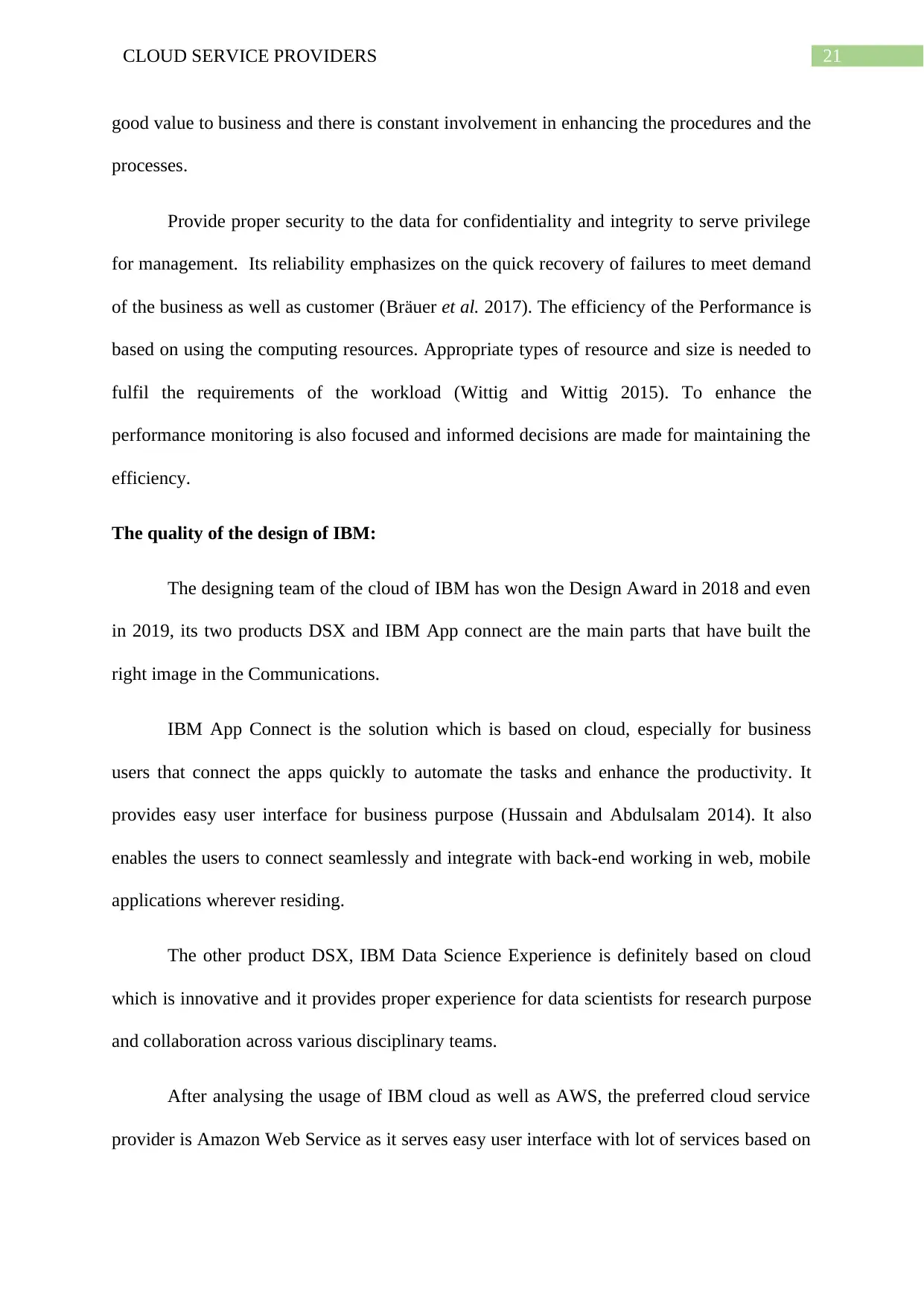
21CLOUD SERVICE PROVIDERS
good value to business and there is constant involvement in enhancing the procedures and the
processes.
Provide proper security to the data for confidentiality and integrity to serve privilege
for management. Its reliability emphasizes on the quick recovery of failures to meet demand
of the business as well as customer (Bräuer et al. 2017). The efficiency of the Performance is
based on using the computing resources. Appropriate types of resource and size is needed to
fulfil the requirements of the workload (Wittig and Wittig 2015). To enhance the
performance monitoring is also focused and informed decisions are made for maintaining the
efficiency.
The quality of the design of IBM:
The designing team of the cloud of IBM has won the Design Award in 2018 and even
in 2019, its two products DSX and IBM App connect are the main parts that have built the
right image in the Communications.
IBM App Connect is the solution which is based on cloud, especially for business
users that connect the apps quickly to automate the tasks and enhance the productivity. It
provides easy user interface for business purpose (Hussain and Abdulsalam 2014). It also
enables the users to connect seamlessly and integrate with back-end working in web, mobile
applications wherever residing.
The other product DSX, IBM Data Science Experience is definitely based on cloud
which is innovative and it provides proper experience for data scientists for research purpose
and collaboration across various disciplinary teams.
After analysing the usage of IBM cloud as well as AWS, the preferred cloud service
provider is Amazon Web Service as it serves easy user interface with lot of services based on
good value to business and there is constant involvement in enhancing the procedures and the
processes.
Provide proper security to the data for confidentiality and integrity to serve privilege
for management. Its reliability emphasizes on the quick recovery of failures to meet demand
of the business as well as customer (Bräuer et al. 2017). The efficiency of the Performance is
based on using the computing resources. Appropriate types of resource and size is needed to
fulfil the requirements of the workload (Wittig and Wittig 2015). To enhance the
performance monitoring is also focused and informed decisions are made for maintaining the
efficiency.
The quality of the design of IBM:
The designing team of the cloud of IBM has won the Design Award in 2018 and even
in 2019, its two products DSX and IBM App connect are the main parts that have built the
right image in the Communications.
IBM App Connect is the solution which is based on cloud, especially for business
users that connect the apps quickly to automate the tasks and enhance the productivity. It
provides easy user interface for business purpose (Hussain and Abdulsalam 2014). It also
enables the users to connect seamlessly and integrate with back-end working in web, mobile
applications wherever residing.
The other product DSX, IBM Data Science Experience is definitely based on cloud
which is innovative and it provides proper experience for data scientists for research purpose
and collaboration across various disciplinary teams.
After analysing the usage of IBM cloud as well as AWS, the preferred cloud service
provider is Amazon Web Service as it serves easy user interface with lot of services based on
Secure Best Marks with AI Grader
Need help grading? Try our AI Grader for instant feedback on your assignments.
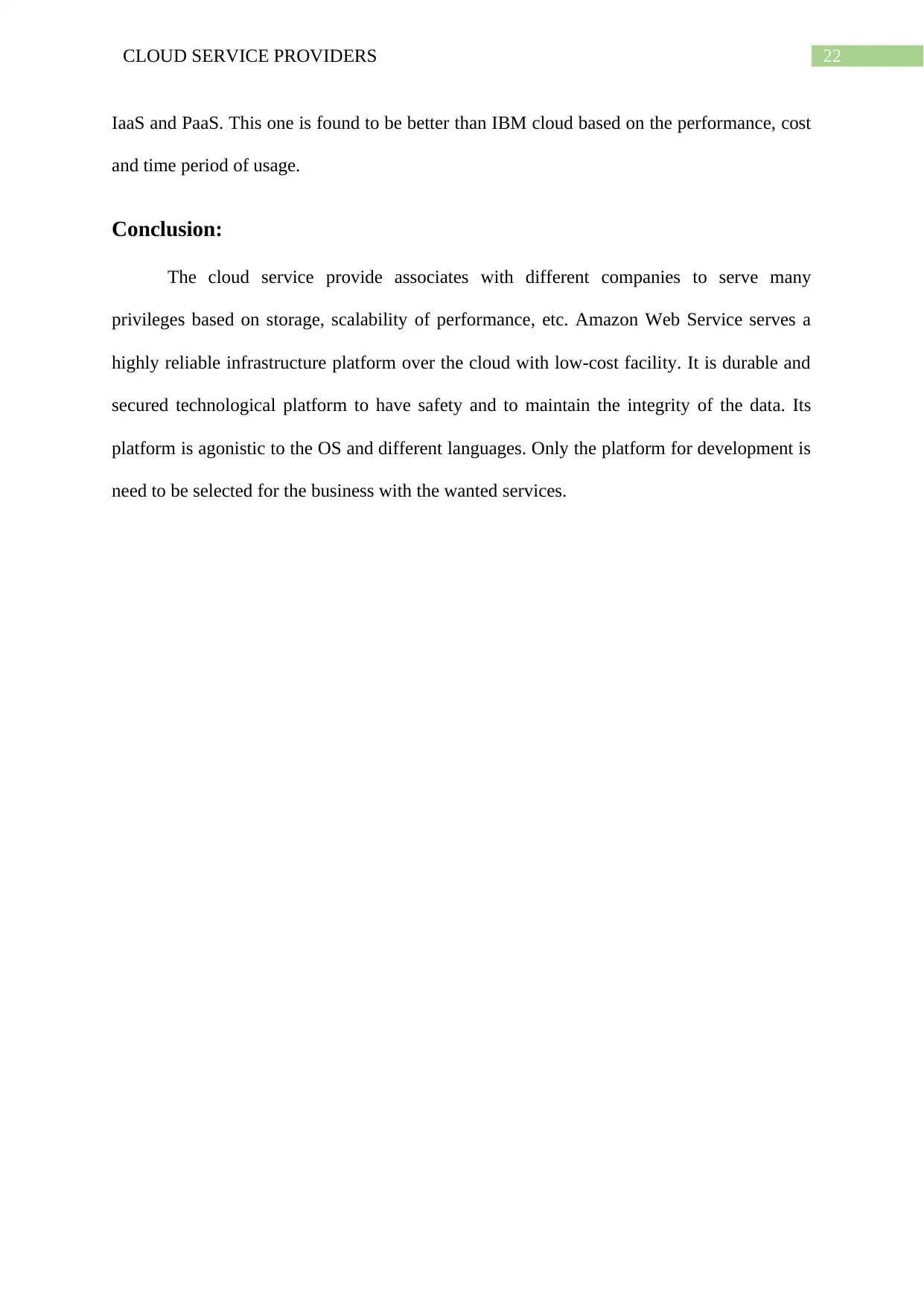
22CLOUD SERVICE PROVIDERS
IaaS and PaaS. This one is found to be better than IBM cloud based on the performance, cost
and time period of usage.
Conclusion:
The cloud service provide associates with different companies to serve many
privileges based on storage, scalability of performance, etc. Amazon Web Service serves a
highly reliable infrastructure platform over the cloud with low-cost facility. It is durable and
secured technological platform to have safety and to maintain the integrity of the data. Its
platform is agonistic to the OS and different languages. Only the platform for development is
need to be selected for the business with the wanted services.
IaaS and PaaS. This one is found to be better than IBM cloud based on the performance, cost
and time period of usage.
Conclusion:
The cloud service provide associates with different companies to serve many
privileges based on storage, scalability of performance, etc. Amazon Web Service serves a
highly reliable infrastructure platform over the cloud with low-cost facility. It is durable and
secured technological platform to have safety and to maintain the integrity of the data. Its
platform is agonistic to the OS and different languages. Only the platform for development is
need to be selected for the business with the wanted services.
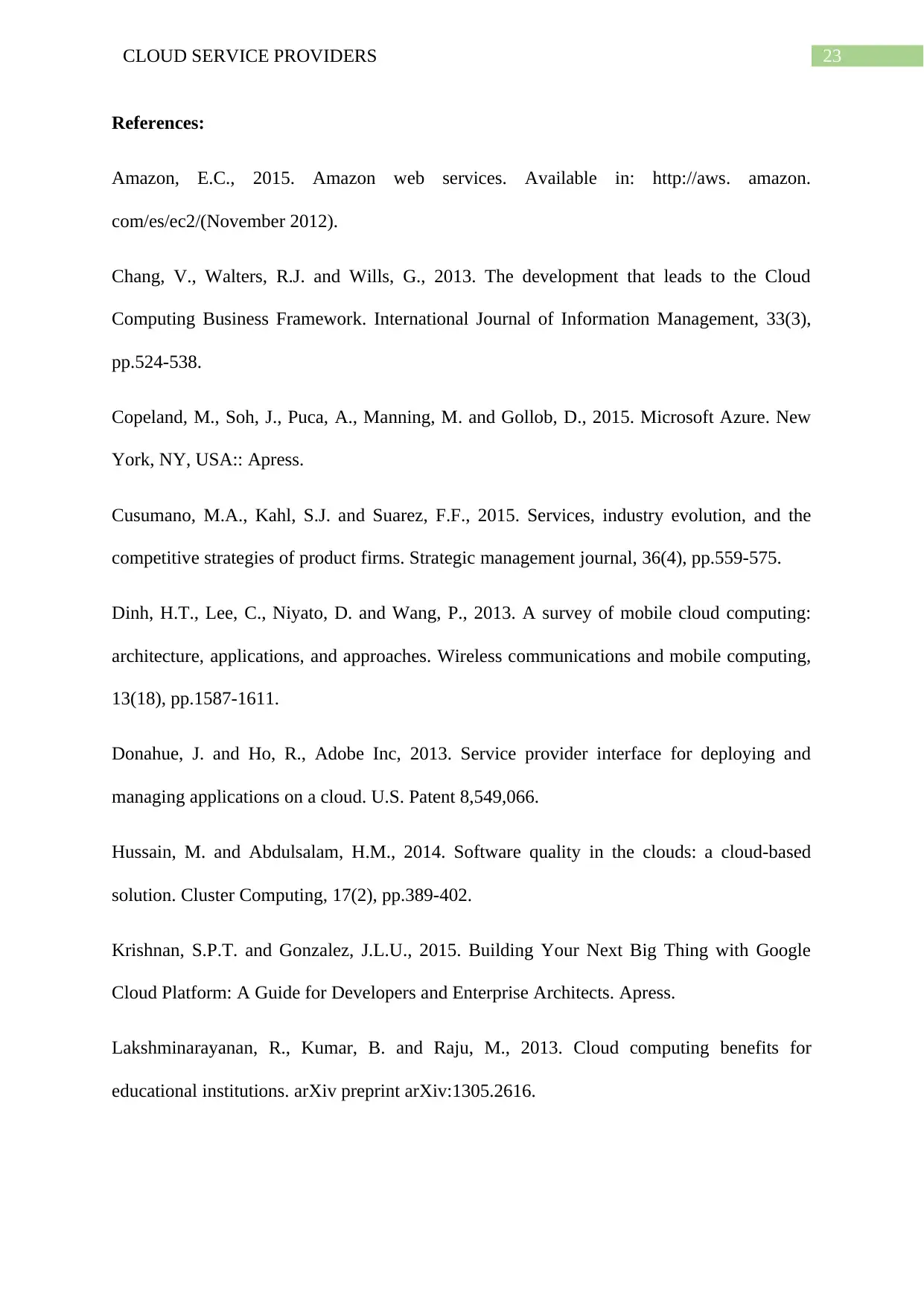
23CLOUD SERVICE PROVIDERS
References:
Amazon, E.C., 2015. Amazon web services. Available in: http://aws. amazon.
com/es/ec2/(November 2012).
Chang, V., Walters, R.J. and Wills, G., 2013. The development that leads to the Cloud
Computing Business Framework. International Journal of Information Management, 33(3),
pp.524-538.
Copeland, M., Soh, J., Puca, A., Manning, M. and Gollob, D., 2015. Microsoft Azure. New
York, NY, USA:: Apress.
Cusumano, M.A., Kahl, S.J. and Suarez, F.F., 2015. Services, industry evolution, and the
competitive strategies of product firms. Strategic management journal, 36(4), pp.559-575.
Dinh, H.T., Lee, C., Niyato, D. and Wang, P., 2013. A survey of mobile cloud computing:
architecture, applications, and approaches. Wireless communications and mobile computing,
13(18), pp.1587-1611.
Donahue, J. and Ho, R., Adobe Inc, 2013. Service provider interface for deploying and
managing applications on a cloud. U.S. Patent 8,549,066.
Hussain, M. and Abdulsalam, H.M., 2014. Software quality in the clouds: a cloud-based
solution. Cluster Computing, 17(2), pp.389-402.
Krishnan, S.P.T. and Gonzalez, J.L.U., 2015. Building Your Next Big Thing with Google
Cloud Platform: A Guide for Developers and Enterprise Architects. Apress.
Lakshminarayanan, R., Kumar, B. and Raju, M., 2013. Cloud computing benefits for
educational institutions. arXiv preprint arXiv:1305.2616.
References:
Amazon, E.C., 2015. Amazon web services. Available in: http://aws. amazon.
com/es/ec2/(November 2012).
Chang, V., Walters, R.J. and Wills, G., 2013. The development that leads to the Cloud
Computing Business Framework. International Journal of Information Management, 33(3),
pp.524-538.
Copeland, M., Soh, J., Puca, A., Manning, M. and Gollob, D., 2015. Microsoft Azure. New
York, NY, USA:: Apress.
Cusumano, M.A., Kahl, S.J. and Suarez, F.F., 2015. Services, industry evolution, and the
competitive strategies of product firms. Strategic management journal, 36(4), pp.559-575.
Dinh, H.T., Lee, C., Niyato, D. and Wang, P., 2013. A survey of mobile cloud computing:
architecture, applications, and approaches. Wireless communications and mobile computing,
13(18), pp.1587-1611.
Donahue, J. and Ho, R., Adobe Inc, 2013. Service provider interface for deploying and
managing applications on a cloud. U.S. Patent 8,549,066.
Hussain, M. and Abdulsalam, H.M., 2014. Software quality in the clouds: a cloud-based
solution. Cluster Computing, 17(2), pp.389-402.
Krishnan, S.P.T. and Gonzalez, J.L.U., 2015. Building Your Next Big Thing with Google
Cloud Platform: A Guide for Developers and Enterprise Architects. Apress.
Lakshminarayanan, R., Kumar, B. and Raju, M., 2013. Cloud computing benefits for
educational institutions. arXiv preprint arXiv:1305.2616.
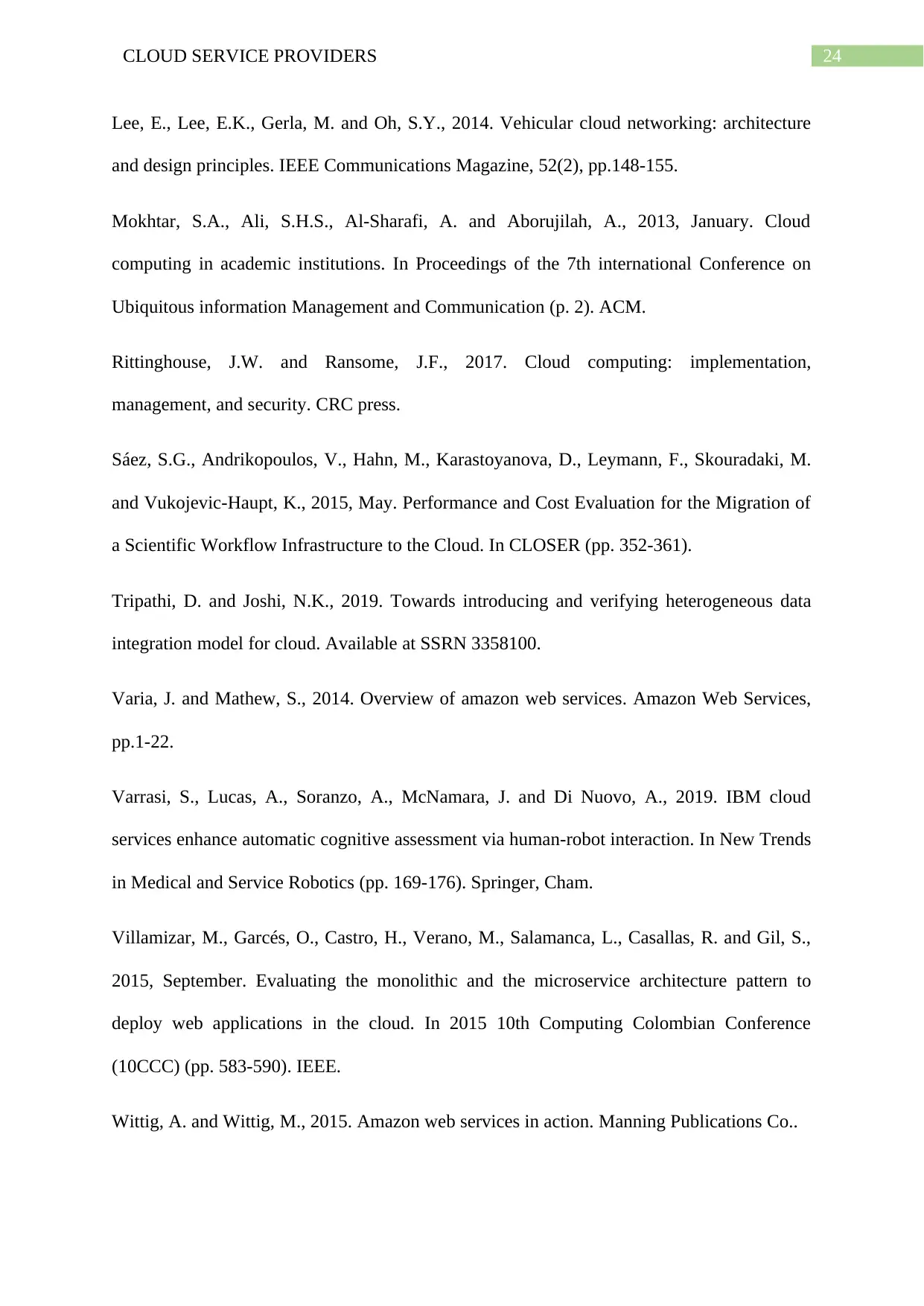
24CLOUD SERVICE PROVIDERS
Lee, E., Lee, E.K., Gerla, M. and Oh, S.Y., 2014. Vehicular cloud networking: architecture
and design principles. IEEE Communications Magazine, 52(2), pp.148-155.
Mokhtar, S.A., Ali, S.H.S., Al-Sharafi, A. and Aborujilah, A., 2013, January. Cloud
computing in academic institutions. In Proceedings of the 7th international Conference on
Ubiquitous information Management and Communication (p. 2). ACM.
Rittinghouse, J.W. and Ransome, J.F., 2017. Cloud computing: implementation,
management, and security. CRC press.
Sáez, S.G., Andrikopoulos, V., Hahn, M., Karastoyanova, D., Leymann, F., Skouradaki, M.
and Vukojevic-Haupt, K., 2015, May. Performance and Cost Evaluation for the Migration of
a Scientific Workflow Infrastructure to the Cloud. In CLOSER (pp. 352-361).
Tripathi, D. and Joshi, N.K., 2019. Towards introducing and verifying heterogeneous data
integration model for cloud. Available at SSRN 3358100.
Varia, J. and Mathew, S., 2014. Overview of amazon web services. Amazon Web Services,
pp.1-22.
Varrasi, S., Lucas, A., Soranzo, A., McNamara, J. and Di Nuovo, A., 2019. IBM cloud
services enhance automatic cognitive assessment via human-robot interaction. In New Trends
in Medical and Service Robotics (pp. 169-176). Springer, Cham.
Villamizar, M., Garcés, O., Castro, H., Verano, M., Salamanca, L., Casallas, R. and Gil, S.,
2015, September. Evaluating the monolithic and the microservice architecture pattern to
deploy web applications in the cloud. In 2015 10th Computing Colombian Conference
(10CCC) (pp. 583-590). IEEE.
Wittig, A. and Wittig, M., 2015. Amazon web services in action. Manning Publications Co..
Lee, E., Lee, E.K., Gerla, M. and Oh, S.Y., 2014. Vehicular cloud networking: architecture
and design principles. IEEE Communications Magazine, 52(2), pp.148-155.
Mokhtar, S.A., Ali, S.H.S., Al-Sharafi, A. and Aborujilah, A., 2013, January. Cloud
computing in academic institutions. In Proceedings of the 7th international Conference on
Ubiquitous information Management and Communication (p. 2). ACM.
Rittinghouse, J.W. and Ransome, J.F., 2017. Cloud computing: implementation,
management, and security. CRC press.
Sáez, S.G., Andrikopoulos, V., Hahn, M., Karastoyanova, D., Leymann, F., Skouradaki, M.
and Vukojevic-Haupt, K., 2015, May. Performance and Cost Evaluation for the Migration of
a Scientific Workflow Infrastructure to the Cloud. In CLOSER (pp. 352-361).
Tripathi, D. and Joshi, N.K., 2019. Towards introducing and verifying heterogeneous data
integration model for cloud. Available at SSRN 3358100.
Varia, J. and Mathew, S., 2014. Overview of amazon web services. Amazon Web Services,
pp.1-22.
Varrasi, S., Lucas, A., Soranzo, A., McNamara, J. and Di Nuovo, A., 2019. IBM cloud
services enhance automatic cognitive assessment via human-robot interaction. In New Trends
in Medical and Service Robotics (pp. 169-176). Springer, Cham.
Villamizar, M., Garcés, O., Castro, H., Verano, M., Salamanca, L., Casallas, R. and Gil, S.,
2015, September. Evaluating the monolithic and the microservice architecture pattern to
deploy web applications in the cloud. In 2015 10th Computing Colombian Conference
(10CCC) (pp. 583-590). IEEE.
Wittig, A. and Wittig, M., 2015. Amazon web services in action. Manning Publications Co..
Paraphrase This Document
Need a fresh take? Get an instant paraphrase of this document with our AI Paraphraser
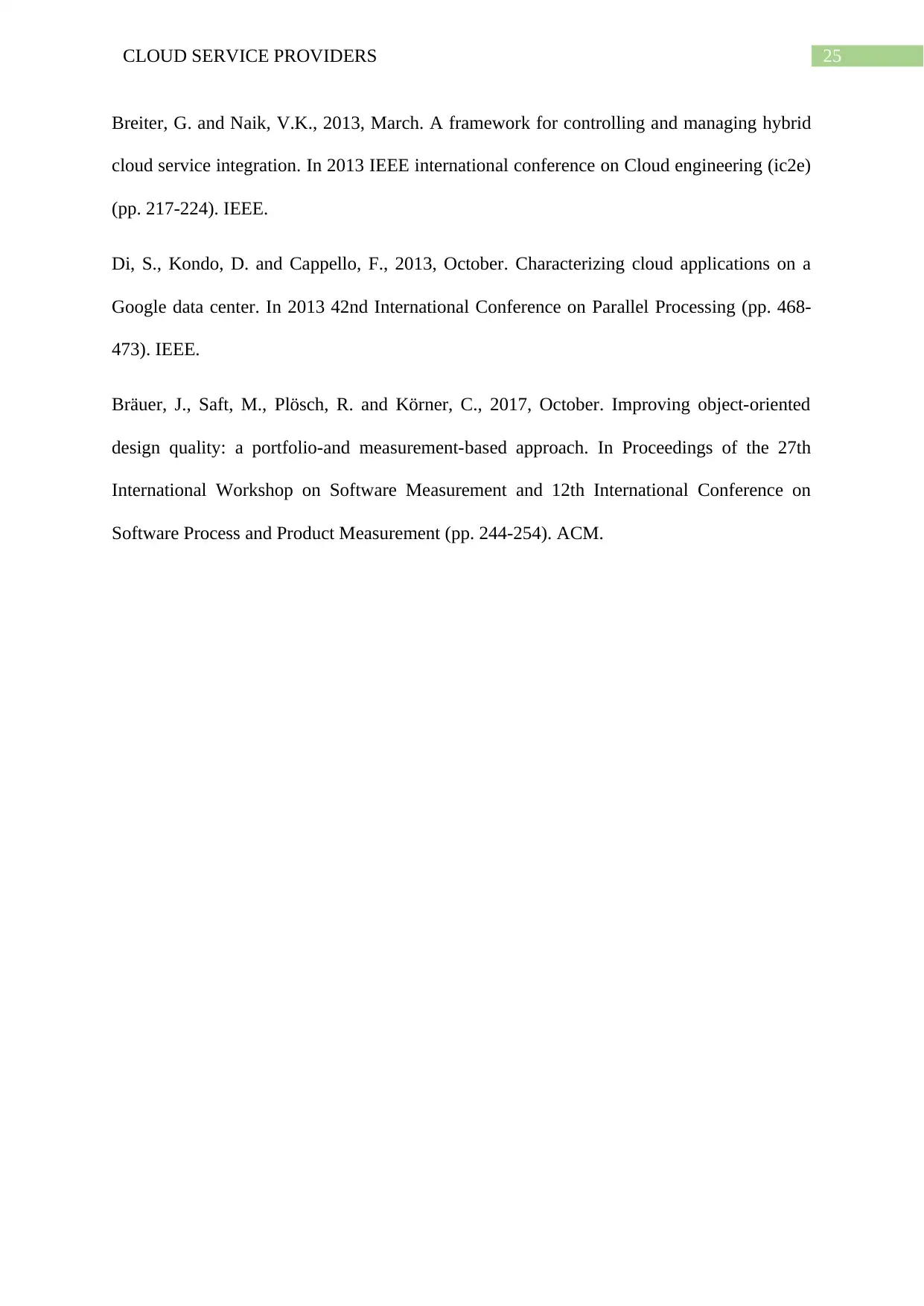
25CLOUD SERVICE PROVIDERS
Breiter, G. and Naik, V.K., 2013, March. A framework for controlling and managing hybrid
cloud service integration. In 2013 IEEE international conference on Cloud engineering (ic2e)
(pp. 217-224). IEEE.
Di, S., Kondo, D. and Cappello, F., 2013, October. Characterizing cloud applications on a
Google data center. In 2013 42nd International Conference on Parallel Processing (pp. 468-
473). IEEE.
Bräuer, J., Saft, M., Plösch, R. and Körner, C., 2017, October. Improving object-oriented
design quality: a portfolio-and measurement-based approach. In Proceedings of the 27th
International Workshop on Software Measurement and 12th International Conference on
Software Process and Product Measurement (pp. 244-254). ACM.
Breiter, G. and Naik, V.K., 2013, March. A framework for controlling and managing hybrid
cloud service integration. In 2013 IEEE international conference on Cloud engineering (ic2e)
(pp. 217-224). IEEE.
Di, S., Kondo, D. and Cappello, F., 2013, October. Characterizing cloud applications on a
Google data center. In 2013 42nd International Conference on Parallel Processing (pp. 468-
473). IEEE.
Bräuer, J., Saft, M., Plösch, R. and Körner, C., 2017, October. Improving object-oriented
design quality: a portfolio-and measurement-based approach. In Proceedings of the 27th
International Workshop on Software Measurement and 12th International Conference on
Software Process and Product Measurement (pp. 244-254). ACM.
1 out of 26
Related Documents
Your All-in-One AI-Powered Toolkit for Academic Success.
+13062052269
info@desklib.com
Available 24*7 on WhatsApp / Email
![[object Object]](/_next/static/media/star-bottom.7253800d.svg)
Unlock your academic potential
© 2024 | Zucol Services PVT LTD | All rights reserved.





